PAGE 3
WINTER GRAZING
Southland is prepared
Page 39

DAIRY EXPO
Pelletised rations
Page 22


PAGE 3
WINTER GRAZING
Southland is prepared
Page 39

DAIRY EXPO
Pelletised rations
Page 22


“Through challenging times, we play an integral part in connecting rural people to each other and to the communities.”
– Rural Support Trust national chair Michelle Ruddell

ations in automatic milking he essence of true pasture-based esent the DairyRobot.
PAGE 4
Picture this. It’s a beautiful evening in February 2026. The paddock you’re standing in used to be one of your worst. Today, it’s your best – new grass and clover are humming, the cows are full and happy.
Making this happen starts right now, if it hasn’t already, according to a leading pasture expert.
“The better organised you are ahead of autumn sowing, the closer you are to pasture you’ll be proud of in 12 months’ time.”
“The better organised you are ahead of autumn sowing, the closer you are to pasture you’ll be proud of in 12 months’ time,” Graham Kerr says.
“Over half the lifetime growth and persistence of new pasture is already set in place before the seed even goes into the ground.”
With 30-plus years’ experience, Barenbrug’s pasture specialist says he’s seen too much new grass tip over too soon for want of careful preparation leading up to sowing day.
The good news? You still have about a month to make sure this autumn is your most successful pasture renewal season yet.

“It’s all about planning,” Graham says. “Whether it’s ordering seed early, so you know you’ll get the
cultivars you want, or booking your drilling contractor now to beat the rush, set yourself up for success.
“What often happens is that as soon as conditions are right, everyone wants to sow new pasture
at once and there is huge pressure on the seed supply chain, as well as contractor availability.”
Another key task to tick off this month is tackling any weeds or pests that will jeopardise new pasture establishment.
Greasy cutworm, for example, was ‘dreadful’ this past spring, and could still pose a real risk to autumnsown grass and clover.
Many paddocks destined for new grass will have already been summer cropped as part of the renewal process.
But Graham says the improved dairy payout offers an opportunity to upgrade poor existing pastures too, generating better feed growth and quality in 2025/26.
“Grass to grass renewal is a great way to put yourself on the front foot for next season, rather than having to live with pastures you know are not pulling their weight.
“With the conditions we’ve had this summer, they might be green. But it’s well worth checking how the cows are performing on them to make sure they’re actually growing quality feed, rather than weeds and unpalatable grass species.”
• For more top tops on autumn pasture renewal, including a free pasture health check, contact Barenbrug today.
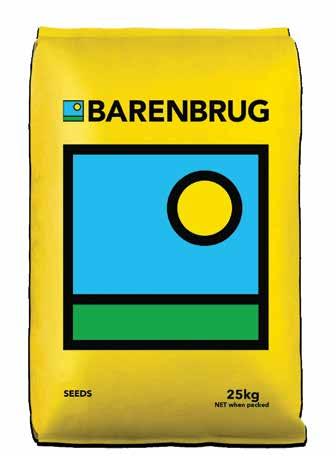



PETER BURKE peterb@ruralnews.co.nz
AG FIRST chief executive James Allen says dairy farmer optimism is on the rise.
This comes on the back of some very positive financial news about the payout with ASB bank forecasting a milk price of $10.25/kgMS.
Allen says there’s going to be some very strong cash flows this season, all being well, and adds that this may extend into next season. He says interest rates are coming down and inflation appears to be under control.
“So, there is definitely a bounce back and more optimism among farmers,” he says.
In terms of the season, Allen says it’s a bit of a mixed bag. He says Southland had a challenging season and Canterbury is looking pretty strong with some moisture there saving a bit on irrigation. He says Taranaki has been drying out a bit but rain in the past few days has helped the situation.
“Waikato is dry and there is probably an orange flag there. But probably most farmers have got a year’s supply of supplement tucked away and just about all our clients are planning to use that supplement to extend lactation,” he says.
He says overall Northland was getting extremely dry but now it has had a reprieve with recent rain
Meanwhile on the West Coast of the South Island, things are tough according to Fed Farmers local dairy chair Frano Volckman who farms 900 cows at Karamea.
The soils on the West Coast are stoney and need regular rain to

counteract any soil moisture deficit. He says much of the coast had a record wet spring which posed challenges and says they are now well and truly dried out and in much need of rain. To deal with the variable weather, Volckman says many farmers have been dipping into their silage reserves just because of the lack of growth with the heat and dry.
“Hopefully we’ll get a few kind months and can bank some more silage to take through to the winter. But I think people will have dipped well into their reserves which will put a bit of pressure coming into the winter,” he says.
Despite the variable weather, Volckman says milk production levels across the coast have held and people have done a really good job keeping their cows in good condition and feeding them well in order to maintain production.

AS A dairy farmer for 22 years, Michelle Ruddell knows the challenges of navigating through the highs and lows of farming.
And, as the new national chair of Rural Support Trust, she also knows the importance of one-on-one support provided to farmers and growers experiencing tough times.
Ruddell took over the chairmanship in September. She also chairs RST Te Tai Tokerau. She has first-hand experience working with farmers under the pump. She joined the RST in 2018 as an agricultural facilitator. During the Mycoplasma. bovis outbreak, she worked with four affected farmers in Northland. As Northland chair, she was also at the forefront of helping farmers recover after Cyclone Gabrielle hit two years ago.
Ruddell admits being initially daunted when elected as RST national chair.

wai, 30km northwest of Whangarei.
“I feel energised and am looking forward to making a lasting impact.”
MICHELLE RUDDELL and her husband Troy are contract milkers on a 350ha farm.
They milk 800 cows and do split calving – in autumn and spring.
The couple employ two full-time staff. Ruddell looks after the accounts and the calf rearing business while raising their three teenage girls.
Ruddell says life on farm is challenging as “you ride the highs and go pretty low through the lows and dark days”.
She doesn’t think women in the dairy industry give themselves enough credit for what they do.
“I’m immensely proud of all dairy women - the support they provide to family, partners and husbands.
“Some days, it’s easier some days amazing and other days hard.
“You live breath and work under the same roof 24/7.
“There aren’t too many places to hide when things get tough. For me the mental challenge has been hard, switching off from farmer to wife, sometime having to take that stress home.”
strong team.
Rural Support Trust, started as a voluntary grassroots organisation as early as the late 1980s, to help support farmers and has gained increased awareness through its services within rural communities and in particular the one-on-one support provided to farmers and growers.
It has 14 regional selfgoverning branches.
Ruddell admits that funding remains a challenge. While the Ministry for Primary Industries provides some funding, it’s nowhere near meeting RST’s operational costs. It relies on donations and fund raising to make ends meet. “Currently it is hard; it’s great to have some MPI funding but that doesn’t come close to meeting operational costs. To meet the shortfall, regions must fundraise,” she says.
with the national body to secure sponsorships for which Ruddell is grateful.
Ruddell points out that the regional organisations are run by mostly volunteers and rely on inkind donations.
“We are grateful to our volunteers, but the challenge is with our workload increasing, how long can these volunteers carry on.”
within three months.
“The key points will be why Rural Support Trust matters, the value we provide and why we should be funded.”
Another avenue of funding could be other government ministries. Ruddell says there’s a great overlap with what they do in the health and mental health space.
ag facilitators working with farmers and growers has jumped from six to 20. The number of active cases that used to between 35 to 40 two years ago has crept up to 150.
RST.
“We have a very important role in helping with the wellbeing of farmers and growers.
“Our ag facilitators across the region are getting more and more work, they are having to employ more ag facilitators to meet that demand.”
“Through challenging times, we play an integral part in connecting rural people to each other and to the communities.
“At first it was overwhelming, but I quickly pushed the self-doubt to the side. I know I’m capable and have got the ability to lead the organisation,” she told Dairy News on her farm at Pipi-
“Perhaps it’s time to look at other ministries, like health,” she adds.
“So, we play a really pivotal role in that oneon-one support and walk alongside farmers and growers.” SUDESH
The national body has to ensure a sustainable organisation and secure funding to run the 300-
The RST has a close working relationship with Fonterra with a sponsorship manager from the co-op working closely
To address the funding challenge, RST is working with social enterprise The Ākina Foundation to tell its story, which reflects the RST’s importance to farming communities.
Ruddell says the report should be ready
Ruddell is in no doubt that the RST is “absolutely making an impact”.
Case numbers are increasing year-on-year, she points out. In Northland, the number of
Ruddell notes that another reason for the jump in cases is RST’s growing profile.
She says more farmers are now referring someone they know, who needs support, to the
“Another key role has been connecting farmers to rural professionals with specialist skillset for challenges faced, be it financial advice, legal advice, counselling or employment advice.

$10,300
$1,000*
SUDESH KISSUN sudeshk@ruralnews.co.nz
CANTERBURY MILK pro-
cessor Synlait is confident of retaining its farmer supplier base following a turnaround in its financial performance.
Acting chief executive Tim Carter told Dairy News that last week’s announcement of new milk premiums for its South Island farmer suppliers “is a tangible way to show them that we are back on track”.
Carter says the response from farmers has been “very positive”.
The listed company has signalled that it expects half-year earnings before interest, taxes, depreciation, and amortization (EBITDA) to January 31 to be in the range of $58 million to $63 million. Last year the company reported a bottom-line loss of $70m.
To keep its South Island supplier base, many of whom had issued notice of cessation of supply to the company, Synlait has announced new premiums.
Carter says that while “the job is not yet done”, the company has made a good start to recover.
He admits that farmer suppliers want surety that Synlait is here for the long term.
“Since 2000s, we have delivered consistent performance except for last few years.
“Our farmers are rightly asking for surety that we are here for the long term.”
Carter says the positive financial forecast and the new milk premiums go hand-in-hand.
“Without our farmers and their milk, we have no business.”
Synlait says it will pay 10c/kgMS premium to South Island farmers committed to a future with Synlait without a cease notice in place. The premium will be in place for the next three seasons, and paid on top of Synlait’s base milk price and in addition to the incentives for specialty milk and its Lead With Pride programme.
The company will also amend milk supply agreements to enhance cashflow security – guaranteeing, from the current season, an average Synlait milk price that matches the market base milk price, and from next season, to match the market advance rate.
Carter says the Synlait team has worked extremely hard to lift productivity and performance in the past six months.
“The announcement demonstrates the huge progress being made and, while we cannot take our foot off the pedal, we are pleased to announce we expect to return to profitability at our upcoming half year result,” he says.


“Farmers are an important backbone to our business. To further recognise that, we have increased our commitment to existing and new South Island suppli-
ers with additional premiums in place for each of the following three seasons. We are confident this will secure our milk supply which is critical to our future.”
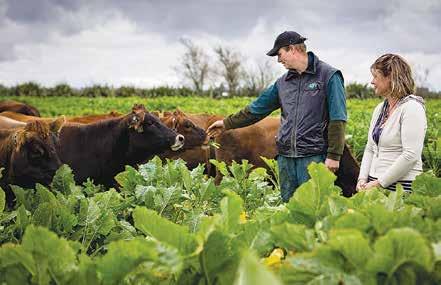



REACTION TO the Government’s major overhaul of the country’s seven crown research organisations has so far been largely positive.
The plan is to merge these into just three entities, to be known as public research organisations (PRO’s).
This will see the creation of a PRO called Bioeconomy which will bring together AgResearch, Manaaki Whenua – Landcare Research, Plant & Food Research and Scion.
The creation of an Earth Sciences PRO will bring together NIWA and GNS and, as already signalled, will see MetService become a whollyowned subsidiary of NIWA.
The former ESR will become the Health and Forensic Science Services PRO with a ‘new’ focus. Finally, a new advanced technology PRO will deliver research, capability, and commercial outreach around advanced technologies such as artificial intelli-

gence, synthetic biology, and quantum. Gone is Callaghan Innovation with the Government saying its functions will be spread among other PRO’s.
A new agency, Invest New Zealand, will be set up as a one-stop-shop for foreign direct investment, to help the Government reach its goal of doubling exports by 2034.
The process and future direction of the new entities will be over-
seen by a new Prime Minister’s science, innovation and technology advisory council. The plan is to have that in place within the new few months with further decisions to be taken on a proposed national IP policy for research and wider incentives for commercialisation, including the operation of technology transfer offices in universities and PRO’s.
Science Minister at the time of the announce-
ment, Judith Collins says the reforms are about maximising value for the $1.2 billion the Government invests in science funding each year. She says they want the new organisations to be adaptable and responsive to government priorities, well-coordinated and avoid unnecessary duplication.
“This work, along with our move to overturn what has effectively been a 30-year ban on gene
technology, will unlock enormous opportunities for our science sector and New Zealanders. The changes are extensive, but they will ensure a science system that generates maximum value for the economy and, therefore, for New Zealanders,” she says.
Legislation creating the reforms is expected to be passed by the end of the year and the new organisations up and running by 2026.
THE CEO of Ag First, James Allen, says it’s not possible to make any detailed assessment of the proposals because the detail has yet to be revealed, but he says he can understand the intent of the proposal.
“What I haven’t seen is any mention of a significant increase in the amount of money for research funding, so I am not clear about what this means for on-farm research.
“There is a clear mandate for the Government around increasing productivity in NZ because that’s what’s going to get the country out its economic hole. So, what this means for on-farm productivity and research around that is what I want to see,” he says.
One of the issues troubling scientists has been the complicated and convoluted bidding process for science funding from MBIE and its predecessor.
Allen says this process soaks up an inordinate amount of time and resources for science managers.
“If the new reforms cuts this down and bring efficiency, that is great, but I suspect that, like all these things, will take time to work through, which begs the question of how long it will take before those efficiencies are gained,” he says.
He says another key factor will be just how agile the new Bioscience PRO will be, given its likely size. James Allen says a lot will depend on who’s leading it and how they can instil a culture of rapid decision making. He says in the business world the catch cry is that the faster an organisation can adapt, the greater its chance of survival.
The CRI’s themselves are supportive of the changes. The convenor of the CRI’s chairs, Kim Wallace, says they are pleased that ESR will keep its current independent status and are happy to see plans to grow something in the ‘big tech’ space.
Wallace says if the changes are done well, they have the potential to enhance the system to create science that will drive NZ’s economic prosperity.

INCREASED FARMER
spending on genetics and animal health has boosted LIC’s half-year profit.
The farmer co-operative posted a net profit after tax of $39 million for six months ending November 30, up 35% over the previous year.
Total revenue rose 8% to $185m. The co-op has also signalled a full-year underlying earnings range of $18m to $22m.
It says the improved results can be attributed to improved economic conditions and farmers choosing to invest in LIC’s products and services like fresh sexed semen, GeneMark Genomics and animal health testing.
LIC board chair Corrigan Sowman expressed pride in the co-operative’s progress, saying,
LIC IS evaluating its strategy to ensure alignment with farmers’ needs and future opportunities.
“To continue delivering for our farmer shareholders, we are revisiting our strategy to ensure it is fit for purpose,” says chief executive David Chin.
“This includes planning for future investments that benefit our farmers. We’ll share updates on this work in the first half of 2025.”
“I am incredibly pleased to see farmers continue to recognise the value of investing in productive herds and resilient farms.
“As a generational co-operative and world leader in pasture-based dairy herd improvement, we will continue to work alongside farmers to improve the profitability and efficiency of the national dairy herd.
As your board chair, I look forward to working with the LIC board and management to continue
delivering value for our farmer shareholders.”
Reflecting on the first half of the financial year, LIC chief executive David Chin noted that the cooperative’s investments are delivering tangible outcomes for farmers.
“We are making significant progress toward breeding cows with lower methane emissions,” Chin says.
“Our research (funded by the New Zealand Agricultural Greenhouse Gas Research Centre) has

confirmed that genetic variation influences how much methane heifers produce.
“We are now one step closer to breeding lowemission cows.
“The next step is the building of a state-ofthe-art research barn to enable large-scale monitoring of lactating cows.


We are proud to contribute to emissions reductions and look forward to offering farmers low methane-emitting genetics soon.”
In addition to methane research, LIC continues to lead in herd improvement through its genomic evaluation tools.
“The launch of our
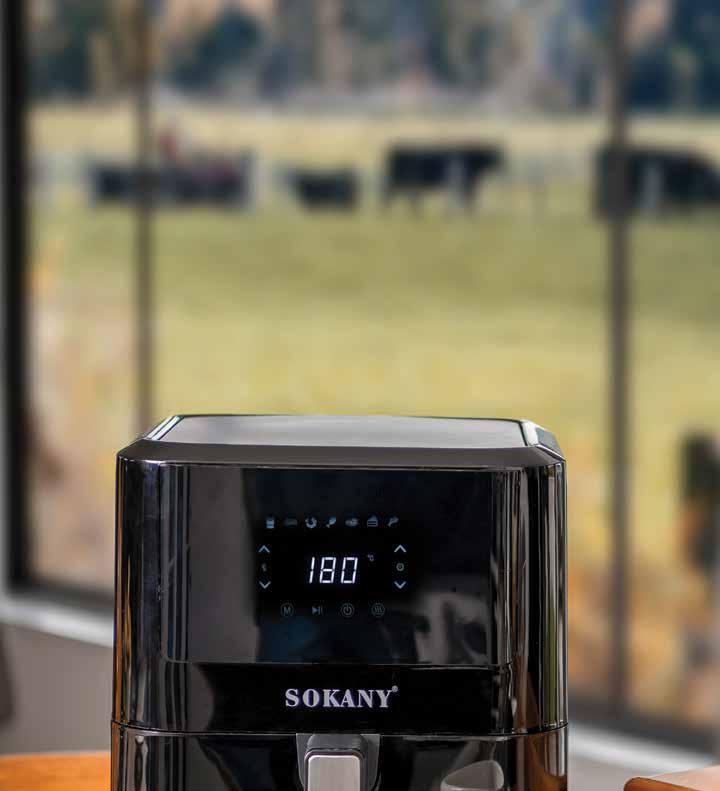
new Genomic product in July 2024 has seen significant uptake from farmers,” Chin says.
“We’ve now surpassed a major milestone, genotyping over 1 million animals. This milestone reflects the growing trust farmers place in these tools to help accelerate the genetic gain in their herds.”
LIC’s commitment to operational excellence has also delivered outstanding results for the fresh sexed semen product.
“The performance of our fresh sexed semen product has exceeded expectations, with 18-24 day non-return rates now within 1% of conventional fresh semen,” says Chin.
“This allows farmers to achieve even better results by breeding from their highest-performing cows.”
Farmers’ focus on herd health is also evident, as demonstrated by a significant increase in Johnes Disease testing. Testing rates have doubled in the first six months of the season compared to 2023, reflecting a growing focus on disease management.



DONALD TRUMP may fancy, and like to get, a Nobel prize for peace, but his chances of getting one for history is mission impossible.
This was after Trump claimed it was an American who first split the atom. Sorry Donald old boy, any kiwi who has seen a $NZ100 bill will recognise the face of Lord Ernest Rutherford of Nelson on the front, and it was he who first split the atom in 1917 at Manchester University. Rutherford was born in Brightwater near Nelson, quite a few km’s from the US of A. Oh and by the way, he won the Nobel prize for chemistry.
Next Trump will claim Phar Lap as a great American racehorse or claim a US citizen invented the pavlova.
A MATE of Milking It’s was recently walking down the main street of the hub of the Horowhenua, Levin, when he saw a ‘pop up shop’ designed to show locals the new toll road bypass from Otaki and past Levin.
Being a tad curious, he started to read the signage in the window, which has been there apparently for several months.
Great idea, they thought, but pity about the spelling. NZTA (Waka Kotahi) states that work is due to “STARRT in 2025”. It seems that despite having a colony of ‘comms’ people in NZTA, none can use spell-check or proofread.
Maybe Transport Minister, Chris Bishop, needs to get his CEO to employ an official spellchecker so we don’t see signs in the future that read “Bee wear – rode werks a hed” .
THE FATE of methane inhibitor Bovaer in NZ farming is still up in the air.
While many countries, including Australia, have approved the use of the feed additive, authorities in NZ are still grappling with allowing NZ dairy farmers to use it.
Controversy erupted just before Christmas, when BBC’s Inside Science podcast reported on a social media backlash to well-known brands of milk, butter and cheese sold at major United Kingdom supermarkets, produced using milk from lower-methane cows.
After false rumours Fonterra was using the product, the dairy giant tweeted last month that food safety and quality were its “number one priority” and that Bovaer had not been approved for use on New Zealand farms.
Back in business?
IS CANTERBURY milk processor Synlait back in business?
After announcing a turnaround in its financial performance, the listed company recorded a 50% rise its share price - from 40c to 60c.
However, it’s worth noting that one year ago, Synlait’s share price was around 80c and two years ago around $3.50/share.
So, the jury is still out on whether Synlait can regain the confidence of investors and of its farmer suppliers, most of whom had earlier indicated their desire to withdraw supply in two years.
WILL THE latest science reforms make the difference that the government hopes?
In theory the idea of merging the ag related science institutes into one conglomerate has merit. Will this avoid duplication? – one hopes so. Will the money given to the new PRO be better spent and will it result in reduced overheads? – again in theory yes or is that a maybe?
There are some good aspects to the reforms including removing the ban on gene technology and setting up an organisation to get more investment into the science sector. While the narrative around the announcement has a good feel about it, its actions not words that will determine success and we have yet to be told what this restructuring will cost. We have also got to get proof that the system will be streamlined so that scientists don’t spend days writing up bids for money for their projects. The present system according to many scientists’ reeks of unnecessary bureaucratic complexity. Many CRI’s have whole departments dedicated to dealing with bids for what sometimes is for small sums of money. So why wasn’t MBIE, the science funder reviewed at the same time?
Science is the key to the success of our primary sector and it’s adoption by farmers, growers and supporting industries. That can only happen when the science is communicated well and made relevant to them. Back in the 1970’s and 80’s NZ this was very good at this, but over time the close connection between farmers and industry and scientists has somewhat faded.
The late Professor Alan MacDiarmid, who won the Nobel prize for chemistry, once told me that there was no point in doing science unless it is communicated properly. Will these reforms deliver that – who knows?
– Peter Burke
• Peter is the founder and life member of Science Communicators Association of NZ and has worked as a journalist in the primary and science sectors for more than 50 years
Head Office: Lower Ground Floor, 29 Northcroft St, Takapuna, Auckland 0622
Phone 09-307 0399.
Postal Address: PO Box 331100, Takapuna, Auckland 0740
by: Rural News Group Printed by: Inkwise NZ Ltd Contacts: Editorial: sudeshk@ruralnews.co.nz
Advertising material: davef@ruralnews.co.nz
Rural News on-line: www.ruralnews.co.nz
Subscriptions: subsrndn@ruralnews.co.nz
Publisher: Brian Hight Ph 09-307 0399
General Manager: Adam Fricker Ph 021-842 226
Editor: Sudesh Kissun Ph 021-963 177
Machinery Editor: Mark Daniel Ph 021-906 723 markd@ruralnews.co.nz
Reporters: Peter Burke Ph 021-224 2184 peterb@ruralnews.co.nz
Subscriptions: Julie Beech Ph 021-190 3144
Production: Dave Ferguson Ph 027-272 5372
Becky Williams Ph 021-100 4831
Digital Strategist: Jessica Marshall Ph 021 0232 6446
AUCKLAND SALES CONTACT: Stephen Pollard Ph 021-963 166 stephenp@ruralnews.co.nz
WAIKATO & WELLINGTON SALES CONTACT: Lisa Wise Ph 027-369 9218 lisaw@ruralnews.co.nz
SOUTH ISLAND SALES REPRESENTATIVE: Kaye Sutherland Ph 021-221 1994 kayes@ruralnews.co.nz



WELCOME TO the
second annual NZ Dairy Expo at Matamata – an event created to bring together the best of the New Zealand dairy industry in a focused, grassroots environment where dairy farmers and rural professionals can meet, talk, compare products, and make smart decisions for their farms.
Born out of need, the Covid-19 pandemic made overseas labour harder to come by, so dairy farmers turned increasingly to automation and technology to simplify systems and reduce costs. This highlighted the importance of creating an event where motivated farmers could directly engage with businesses offering the latest tools, technology, and solutions.
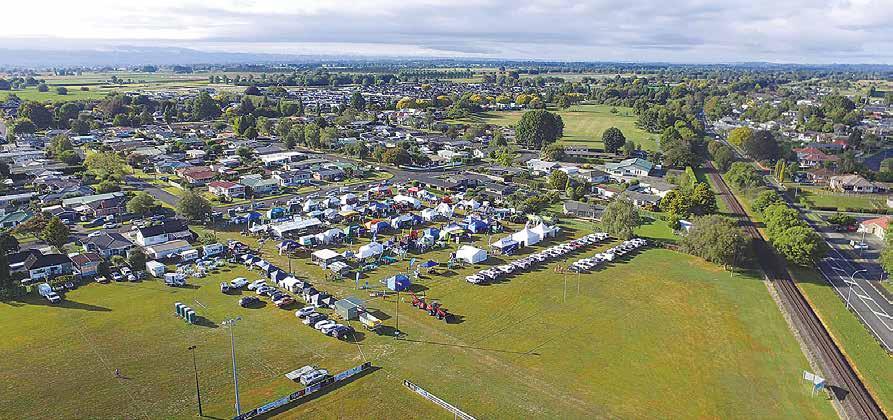
Register and attend the New Zealand Dairy Expo to win a Milwaukee M18 Cordless Grease Gun Starter Kit.
What: NZ Dairy Expo
When: February 11th and 12th, 2025 Where: Bedford Park, Matamata
Time: 8.30am to 3pm
Register on website: nzdairyexpo.co.nz Entry is free!
Unlike regional and national field days, the NZ Dairy Expo is specifically for dairy farmers, where every exhibitor has something valuable to offer, whether it’s innovative technology, quality infrastructure, or essential services or advice. We keep it free for farmers, without unnecessary cost but with a key focus, so you won’t find container loads of lifestyle products or unrelated goods here.
This event is proudly
run by a small team of people who are passionate about supporting NZ’s dairy sector whose key aim is to create a meaningful Expo, not make a profit. We don’t take sponsorship from big corporates because we believe in maintaining our independence, allowing us to steer the event in a direction that best serves the industry, without any external influence.
Hosted at Bedford
Park, the home of the UMS Rugby Club, it’s our way of giving back to the local community, supporting junior rugby, and helping sustain the club itself.
Running from 8:30am to 3:00pm on Tuesday 11th and Wednesday 12th February, the timing is scheduled to fit between milkings, so you can attend without disrupting busy schedules.
While registration isn’t mandatory, we encourage you to sign up online in advance so we can ensure there are enough amenities

for everyone. Signing up online at www.dairyexpo. co.nz or on arrival at the gate offers visitors the chance to win and to take home a daily prize of a Milwaukee M18 Cordless Grease Gun and starter pack.
With over 120 exhibitors spread across more than two hectares, we recommend allowing yourself 3 to 4 hours to fully explore the Expo. We’ve encouraged our exhibitors to focus on what really matters,
from bringing their best people, offering straightforward, practical solutions, without the need to spend a fortune on site fit-outs.
Whether you’re here to learn, network, or find a solution, we hope you
enjoy your time at the Expo. Thank you for supporting an event that’s by the industry, for the industry.
We hope to see you around the grounds!
• Amanda Hodgson is the owner of NZ Dairy Expo



DAIRY AND beef farmers
could be eligible for lower interest lending options for financing Halter on their farms, with ANZ, ASB and BNZ now offering a pathway to sustainability loans for New Zealand’s largest virtual fencing provider.
The lending options provide a potential opportunity for greater affordability and access to Halter’s virtual fencing system used by hundreds of farmers and are open to existing and prospective Halter customers who meet eligibility, lending and identification criteria.
The banks’ preferential rates are based on: ANZ’s business green loan floating rates, ASB’s special purpose base rate and BNZ’s reduced floating and fixed rates, tailored to individual clients.
Halter notes that products/rates are subject to change. Lending and eligibility criteria, terms, conditions, and fees may apply.
Farmers also receive a 10% discount from Halter for paying 2-years up front via the sustainability loans, with the flexibility of monthly repayments.
For example, compared to average term loan lending rates, a typical 500 herd dairy farm could save up to $4,700 across two years through a lower interest sustainability loan and Halter discount. This example, for demonstration purposes only, is based on a 6.15% interest rate and 10% Halter discount for 2-year upfront payment terms.
“These offerings unlock pathways to sustainable lending across

the lion’s share of rural lenders and is another step towards helping Halter farmers run more productive, sustainable and resilient farms,” says Halter partnerships man ager Steve Crowhurst.
“As well as driving farm performance and profitability, Halter is a tool that helps farmers easily deploy sustainable farming practices out lined by industry bodies. Halter incorporates vir tual fencing and herd ing, precision pasture management, and animal health and location moni toring.”
Halter farmers are advancing their sus tainability outcomes by reducing fuel through less farm vehicle use (some by up to 47%), increas ing pasture harvest and therefore reducing the need for supplements, and reducing nitrogen via more strategic application informed by cow loca tion data.
They can also improve
fertility which reduces the number of heifer replacements needed on farm and therefore overall farm emissions.
Halter’s virtual
ity and bandwidth to farm in a way that mitigates impact on the environment.”
Halter farmers are achieving financial gains by generating more milk in the vat and the potential to achieve better live weight gains.
Farmers interested in these sustainability loans can visit www.HalterHQ. com/financing or speak to their bank’s relationship manager.
Farmers banking with Westpac and Rabobank can also reach out to their relationship manager for alternative lending options for Halter services.
@dairy_news


PASTURE RENEWAL is the process of replacing older, less productive pastures with a completely new pasture.
Often this is taking the worst or most underperforming paddock on the farm and attempting to make them the highest performing. To achieve this, several checks need to be made to get a successful pasture renewal result.
According to Agricom, the most important is to identify the reason for the paddock underperforming to start with:
Checking the paddock fertility
Identifying issues of drainage or compaction
Identifying the weed and weed grass species limiting productivity
Identifying the insect pests that mostly influence your pasture pro-
duction and persistence
Agricom says this process will identify whether you can do a double spray grass-to-grass programme or whether you require a cropping rotation to reach your end goal of a productive persistent pasture.
“Replacing poor producing paddocks with new pasture is one of the simplest ways to invest on farm for a significant and relatively predictable return. The higher your farm’s performance, the more it can gain from intensified pasture renewal. And it isn’t only for ‘high input’ farms - any kind of farm or grazing-based business can benefit from pasture renewal.”
New pasture is much more productive, says Agricom. Most pastures deteriorate from a





number of causes - weed invasion, particularly low quality grasses like paspalum and Mercer grass, dry conditions, wet/ flooding, poor fertility, poor drainage, diseases, insects, pugging, soil compaction, overgrazing and poor management.
Over time, the population of desirable, productive plants in a pasture declines, while undesirable or unproductive plants increase and pastures become ‘runout’. Old pastures produce less drymatter, are lower in metabolisable energy (ME) and have reduced stock performance. This
decline compounds as the pasture ages.
Successful pasture renewal can increase DM/ ha/year by around 3–6 tonnes. This is true for all farms – the extent to which the extra production can be converted into additional income varies.
According to DairyNZ, renewing pasture is crucial for maintaining healthy dairy farms, and there are four primary methods to consider: cultivation, spray-drilling, undersowing, and oversowing. Each method has its pros and cons, with factors like cost, time, and specific pas-
THE CORRECT rate of pasture renewal for a farm varies depending on the state of the pastures, and the goals of the operation.
Barenbrug covers how to assess pasture performance across a farm and plan accordingly.
Rate of renewal
Pasture renewal programmes vary widely across NZ, ranging from 0% to over 30% of the farm area each year.
Dairy farm renewal averages about 8% compared to 2-5% on sheep farms. The percentage of a farm renewed also determines how long a pasture must last, for example a 5% rate of renewal means a pasture must last 20 years.
Benefit of renewal
The benefit of new pasture is the gains it will deliver over existing pasture.
So it’s important to estimate the current pasture performance versus potential.
Pasture growth varies widely be -
ture conditions influencing the choice of renewal approach.
DairyNZ advises farmers to choose the method that aligns with their farm’s needs and conditions.
There are four main ways to renew pasture, cultivation, spray-drilling, undersowing and oversowing.
Cultivation
Involves breaking up the soil prior to sowing with the likes of a plough, power harrow, discs or rotocrumbler. It is necessary where there is a need to eliminate compaction or levelling, or lime incorporation is required.
Advantages
■ Most consistent results
■ Eliminates compaction
■ Best pest & weed control
■ Can level paddock
■ Can incorporate lime
■ Allows good soil coverage by seed
Disadvantages
■ Most expensive method
■ Slower to first grazing (6-10 weeks)
■ Softer and more prone to pugging during establishment
Spray and drill
A direct-drill is used to sow treated seed into an uncultivated paddock after existing pasture killed by herbicide.
Advantages
■ Herbicide controls competition
■ Less expensive and less time consuming than cultivation
tween individual paddocks across every farm. On flat farms there is typically a 100% difference in DM yield between best and worst paddocks. This difference is much higher on hill country properties.
Growth differences between dairy paddocks of 6 t DM/ha are common. This means under-performing paddocks may produce 300 kg MS/ha less than better ones (based on 75% utilisation and 15 kg DM/kg MS conversion).
Measuring paddock performance
Comparing the performance of individual paddocks allows you to quantify the potential gains of pasture renewal on the farm.
The best paddocks show what can be achieved, with the difference between those and the worst illustrating the potential for improvement, provided paddocks share similar topography and soil type.
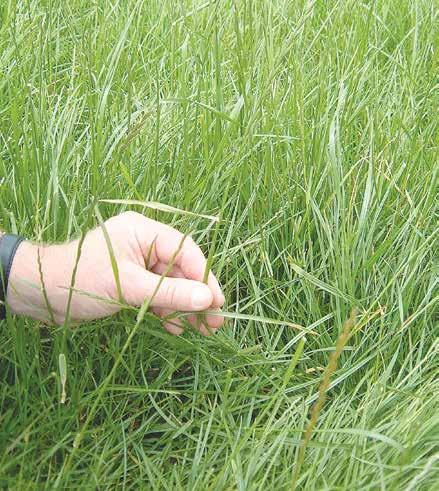
■ Quicker to first grazing (6 weeks)
■ White clover establishment is possible (see below)
■ Long term solution
Disadvantages
■ Less opportunity to correct pH
■ Won’t fix soil compaction or level paddock
■ May revert to old pasture more quickly than cultivated paddocks
■ Two drill passes at half the seeding rate are desirable to achieve dense pasture
■ Loss of pasture production after spraying White clover establishment (after killing existing pasture) Drill ryegrass using
the main-seed box. Drop white clover seed onto the soil surface from the small-seeds box in front of coulters sowing the ryegrass. Cover seed with a brush or bar harrow.
Undersowing
Use a direct-drill to sow treated seed into existing pasture. Works very well in the narrow window of time when a pasture has thinned out but has not yet been overtaken by weed ingression. Use after extended dry conditions where large areas need to be sown, or after winter pugging damage. Results are variable where it’s used in pastures too dense for
the new seedlings to establish well.
Advantages
■ Cheap and simple
■ Allows large areas to be done
■ Italian or hybrid can boost winter-early spring growth
Disadvantages
■ Doesn’t work in dense pastures
■ Doesn’t control problem weeds
■ Not suitable for white clover establishment
■ Usually only a temporary fix
Oversowing
Treated seed is broadcasted on to the surface of the soil.
Generally used to repair smaller areas, for
example after pugging damage, or to establish white clover in spring into pastures where the land is too steep or stony for cultivation.
Not recommended for improvement of lowland pastures due to high seeding mortality.
Sowing rates are generally higher, as establish-
ment rates of seed placed on the ground surface are lower.
Advantages
■ Can introduce legumes & N fixation
■ Can apply with fertiliser
Disadvantages
■ Variable results
■ Hard to control competition


DEPENDING ON your perspective, dairy farming brings with it the joys or problem of dealing with animal waste, be it liquid slurries or more solid manures.
With the growing cost of synthetic fertilisers slashing bottom lines, the use of natural manures can help augment soil fertility and make a positive financial impact.
FarmChief imports and distributes the UKbuilt West Dual Muck Spreader, a watertight, side-discharge machine that offers the benefits of being able to spread liquid slurries or heavy, solid farmyard manures and all grades of product in between.
Featuring a heavy-duty
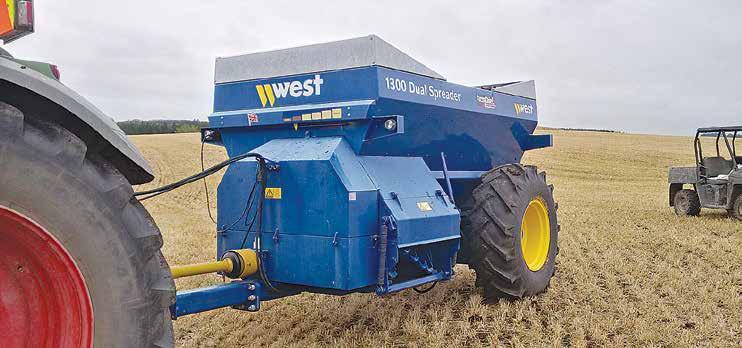
tub design, the five-model range offers capacities of 5.9 to 13.6 cubic metres, with tare weights of three to five tonnes, with horsepower requirements of around 70 to 130hp.
At the heart of the
•
•
machine, in the base of the tub, a heavy-duty auger, mounted on an 80mm diameter shaft sitting on long-lasting bushes, rotating at 10rpm, serves to keep the manure agitated and
moving towards the front of the machine.
At the forward end of the rotor, close-coupled impellors ensure a smooth flow of material to a side-mounted, underslung, rigid impel-




lor, rotating at 500rpm, that creates an even spread. During operation, a mechanically driven, continuously oscillating side plate helps stop any bridging or stopping of material as it moves for-
ward. Designed to disperse the material in a fine spread pattern of up to 21m, depending on material, the discharge rotor features reversible and replaceable tips to ensure a long service life.
At the discharge point, a hydraulically adjustable guillotine door allows accurate control of spreading rate, while the spreading rotor is complemented by a springloaded lower housing to pass without damaging the machine.
The main driveline is protected from overload by a shear-bolt on the input shaft.
A low centre of gravity and large flotation tyres mean the load is spread evenly, helping to reduce ground compaction in the paddock, while also improving the towing experience on both the road and on rolling country. Given the overall weight of the loaded unit, hydraulic brakes are fitted standard for safe stopping a control.
Visit Farmchief at site number 8.

MAKING FARMING easy is what the TechniPharm team says it lives for.
With a 35-year reputation in the market pace, the company says their products solutions are innovative and well proven.
One of their innovations, the Dungbuster Auto yard cleaning system, is now employed at many dairy sheds around the country. And when it comes to measuring productivity improvements, Dungbuster is at the top of the list, the company says.
With most yards taking between one to two hours a day to clean by manual yard hose, it’s a “labour sucker”.
“With Dungbuster this time requirement is eliminated: That is not a 100% productivity improvement or a 1000% improvement, it’s an eliminating improvement.
“Freeing up time for far more important jobs or creating more time to recharge for the day ahead, or an evening game or outing with the family.
“Additional benefits amount to reduced water use, reduced effluent creation, reduced power use, and reduced greenhouse gasses. All in all the investment in Dungbuster delivers and continues to deliver day after day.”
Technipham points out that one of their long term users of Dunbustger has described it ‘as a game changer on my farm’.
Talk to the TechniPharm team on site 17 at Dairy Expo and inspect their other Make Farming Ezy solutions in hoofcare, animal handling, yards, effluent storage and general tools and aids.
PRIMARY ITO has a wide range of work-based training options to help you grow the skills and knowledge of your staff in 2025.
Our team and I will be at the Dairy Expo to talk you through the options, from entry level skills to micro-credentials (bitesized pieces of learning), apprenticeships, and more. We’d be delighted to share what’s involved and help identify the best options for your team.
This year is the perfect time to train your staff, with several exciting initiatives available now at 50% off fees in 2025 The popular 50% off fees for agriculture training has been extended into 2025. This is available for our NZ Certificates (Level 3 and 4).
In the face of ongoing cost pressures on farmers, this offer aims to help make training more accessible for all. We look forward to seeing even more of you take advantage of this fantastic offer this year.
Apprenticeship Boost payment for employers
The Government has extended the Apprenticeship Boost payment into 2025, with up to $6,000 available for agriculture employers with first-year apprentices.
This is excellent news for employers looking to take on, train and retain new workers.
The payment of $500 a month from Work and


Income is only for firstyear apprentices. It recognises the time and effort made by employers taking on new staff, and the value that workbased training adds to a business.
Short courses for all visa holders
Primary ITO has launched two new dairy short courses that provide affordable and flexible options for all dairy staff, no matter their visa or residency status.
The Dairy Basics: Milking course covers key knowledge in milking and dairy plant hygiene. This includes describing and reporting on milking problems, risks to on-farm milk quality, and how to prevent and implement solutions to milk quality problems.
The Dairy Basics: Effluent course provides knowledge on effluent




management at all stages, from production to storage and spreading. It also covers monitoring a dairy effluent management system.
Developed in response to industry demand, both courses are suitable for farm assistants and relief or experienced milkers who want to develop or refresh their knowledge. They are available any time of year.
Learners will take part in one or two short offjob workshops, where they will complete a workbook, engage in interactive activities to put theory into practice, and share knowledge and
experiences with other course participants. These courses are non-formal, meaning learners will not complete any formal assessment. They will receive a certificate of attendance upon completion. Each course has a similar level of content to a Level 3 programme.
Find information on all of these exciting initiatives on our website (primaryito.ac.nz). Or come and chat to our friendly team at the Dairy Expo –site 25. We look forward to seeing you there!
• Marianne Awburn is sector manager for agriculture for Primary ITO.
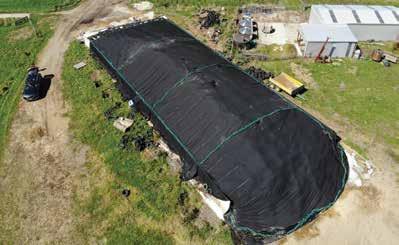



PRECISION SLURRY
says they are effluent application specialists who pride themselves in
leading the way in cleaning out any system –fully utilising the nutrients often seen as a
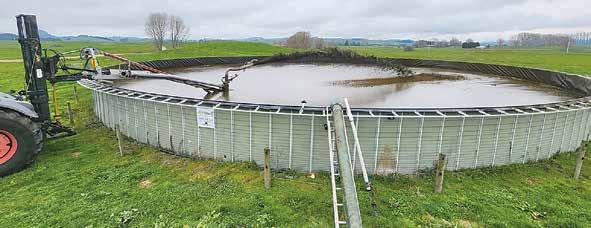
problem on farms.
Owner operators Glen Crafar, his wife Paula, and Robert Crafar have
been farming their whole lives and have a wealth of experience in how to stir







and spread the most difficult of jobs.
Based in Reporoa and
servicing the Central Plateau, Bay of Plenty and South Waikato, Precision Slurry has a full range of specialised equipment to tackle any job:
■ Lined and unlined ponds
■ Above ground tanks
■ Bladders
■ Weeping walls
■ Sumps
The modern fleet is well equipped with GPS systems, application rate control and proof of placement. Nutrient analysis is also available.
Precision Slurry says customers are pleasantly surprised, commenting ‘l didn’t know the pond
was that deep’ or ‘I didn’t think you’d get it that empty’.
It says the slurry that’s spread is rocket fuel for grass growth, often transforming weaker paddocks to strong ones.
“Effluent is hundreds of tonnes of fertiliser which is already on farm, that just needs to be well stirred and spread onto the land so it can start producing more feed.
“In most cases the fertiliser value outweighs the cost of applying it, not to mention the operational benefits of having a de-sludged effluent system.”
ECOBAG™ is fully contained so you are fully covered for unwanted added rain water and objects which “may get into the pond” No issues with liner gas bubbles as this system is fully contained and gas can escape trough the sides.
Less or no evaporation of valuable N, almost no smell and no crusting ever.
System includes
for





















FOR OVER 40 years, Williams Engineering has been trusted by farmers across New Zealand and beyond to deliver simple, reliable, and cost-effective effluent solutions that make farm life easier.

With decades of experience, we’ve built a trusted network of dealers in New Zealand and beyond to ensure farmers benefit from practical effluent solutions that save time and reduce your workload over the long-term.
At Williams Effluent Solutions, we understand that every farm is unique, so our team works closely with customers to create a customised system that supports a farm’s productivity, while ensuring regulatory compliance and environmental sustainability guidelines are fully met.
Our goal is to help implement a solution that reduces stress and keeps an operation running smoothly, without relying on extra labour.
Our services include effluent system design and compliance, on-farm installation and servicing, concrete infrastructure and manufactured products –so are you ready for peace of mind with a reliable effluent system?
-Supplied by Williams Engineering
EFFLUENT IS a valuable source of nutrients.
Good effluent management on a dairy farm not only saves on fertiliser costs and enhances soil health but also helps prevent animal health problems associated with high potassium levels in the soil.
Good effluent management is also important to ensure compliance with the relevant regional plan rules, which are in place to protect the health of ground water and surface water.
Effluent must only be applied at a rate suitable for the soil conditions. Any ponding of effluent on the land surface following application is
unlawful. It is important that you know how much the irrigator is applying, adjust application rates according to soil conditions and know how concentrated the effluent is.
Effluent storage facility should also be correctly sized for individual farm system and management. The Dairy Effluent Storage Calculator (DESC), from DairyNZ, is an excellent tool for determining the volume of storage required for farm dairy effluent system. Accredited Effluent System Designers and Dairy Effluent WOF assessors can assist in ensuring this calculation is accurate and appropriate for the farming

operation. They can also provide suggestions on where system efficiencies
can be improved. Having adequate storage means that a farm:
■ Can defer irrigation in wet weather when soil conditions are unsuit-
able to irrigate.
■ Lower the risk of effluent ponding, runoff and leaching to groundwater in wet weather.
■ Have the ability to irrigate effluent when plant uptake is maximised.
■ Can store effluent during mechanical breakdown.
■ Can defer irrigation during busy times e.g. calving.
■ Increasing your effluent application area means that a farm can:
■ Spread nutrients further, reducing fertiliser requirements and associated costs.
■ Slow the build-up of potassium in effluent
paddocks which can lead to animal health problems.
■ Have more flexibility in grazing around effluent applications and safer withholding periods prior to grazing.
Waikato Regional Council encourages farmers to develop an effluent management plan (EMP) for their particular farm. To get value from the EMP it should be tailored to the farm effluent system, farming operation and resources. All farm staff should be inducted and trained in operating the farm effluent system and understand the content of the EMP.

Precision Slurry customers always comment “l didn’t know the pond was that deep” or “I didn’t think you’d get it that empty” and the slurry that’s spread is rocket fuel for grass growth often transforming weaker paddocks to strong ones. Call now for a free consultation 027-4716 199 Check out what we can do at www.precisionslurry.co.nz
Precision Slurry are effluent application specialists who pride themselves in leading the way in cleaning out any system - fully utilising the nutrients often seen as a problem on farms. Owner operators Glen, Paula (Glen’s wife) and Robert Crafar have been farming their whole lives and have a wealth of experience in how to stir and spread the most difficult of jobs. Based in Reporoa and servicing the Central Plateau, Bay of Plenty and South Waikato Precision Slurry has a full range of specialised equipment to tackle any job whether it be: • Lined and unlined ponds • Above ground tanks • Bladders • Weeping walls • Sumps. The modern fleet is well equipped with gps systems, application rate control and proof of placement. Nutrient analysis is also available.
Effluent is 100’s of tonnes of fertiliser which is already on farm that just needs to be well stirred and spread onto the land so it can start producing more feed. ‘In most cases the fertiliser value out weighs the cost of applying it not to mention the operational benefits of having a de-sludged effluent system.’


FOR OVER 20 years
Advantage Plastics has been manufacturing and supplying New Zealandwide a large range of onfarm storage & handling equipment.
From storage silos, portable hoppers to feeders, to name a few, all products are manufactured from polyethylene, the benefits of which have been proven and
tested on the largest farms throughout New Zealand.
With a recent increased range of products for the dairy industry, which included a












large range of calf meal equipment, the company says it is to make your life on farm easier and more efficient.
“Always keen to listen to feedback and having manufactured customised solutions for years, we saw an opportunity with several of our customers to utilise our Smart Stakkas into a feed out trailer, with an unloading auger that could be operated from your vehicle, side by or quad bike.
“This would help a lot on farm, especially when feeding out into troughs, by removing the need for back braking work of manhandling bags etc.”
This has resulted in a 1-tonne feedout trailer, released last year. With many improvements over
time, the company says it has become the ultimate solution needed on farm, proven by many, saving time and money. Key features include a heavy duty trailer which is hot dipped galvanised, 5-inch foldaway auger that reduces the unit’s overall width making it safer for transport, it is fast discharging, it has a slide gate to reduce flow if needed, and remote on/ off switch which allows ease of use from a distance and means the operator is kept safe. Designed to be powered by a portable generator, the feedout trailer can be used for several applications, making it a worthwhile investment. Visit site number 35 or www.advantageplastics. co.nz

DTS, NEW Zealand’s leading manufacturer of stainless steel vats and refrigeration technologies, is spearheading a groundbreaking initiative to phase out R404A refrigerant gas, a major contributor to greenhouse gas emissions.
Long used in dairy, horticulture, and commercial cooling systems, R404A is known for its high global warming potential (GWP) of 3922 and skyrocketing costs. DTS is replacing it with R449A, a more environmentally friendly and energy-efficient alternative with a GWP of just 1397 – one-third that of R404A.
Luke Walker, DTS national sales and service manager, explains the rationale behind the initiative.
“Many producers
don’t realise the environmental and financial impact of their refrigerant until a leak occurs and they’re hit with an expensive re-gassing bill,” says Walker.
“By swapping R404A for R449A, we’re not only reducing costs but also making a significant positive impact on the environment.”
The swap-out is part of DTS’s proactive service contracts and is designed to be seamless and costneutral. The transition requires minimal adjustments, such as a valve replacement in some systems, and poses no additional operating risks. DTS says R449A not only reduces environmental harm but also improves energy efficiency by up to 10%, which translates to lower power consumption and further emis-

sion reductions. Farmers like Cam Lewis, a fourthgeneration steward of the Dunoon property in Foxton, are embracing the initiative.
“This decision was an absolute no-brainer,” says Lewis. “For us, it’s about
balancing environmental responsibility with financial practicality. The swap ticks all the boxes—it’s seamless, cost-neutral, and reduces our exposure to the soaring costs of R404A.”
DTS says its com-
mitment to sustainability goes beyond simple replacements. The company has already extracted four tonnes of R404A from New Zealand’s cooling systems in the first year of its campaign. This equates
to preventing 10,000 tonnes of CO₂e emissions—equivalent to the emissions from driving a diesel vehicle 60 million kilometres. With around 700 tonnes of R404A still circulating in New Zealand’s refrigerated food chain, DTS aims to remove at least another four tonnes in the coming year.
Gavin Thwaites, CEO of DTS, highlights the broader implications of the initiative.
“The transition away from harmful refrigerants like R404A is a critical step for a sustainable future. Every reduction counts, and we’re committed to helping New Zealand producers make this change efficiently and responsibly.”
Beyond the immediate benefits of the swap, DTS is exploring partnerships
with government and industry players to accelerate the transition. The company is also investing in new technologies and manufacturing practices to reduce reliance on harmful hydrocarbon gases across the dairy and cold food chain sectors.
As Walker concludes, “DTS is more than a manufacturer—we’re problem-solvers and innovators. Our mission is to help New Zealand producers build sustainable, efficient operations that align with the environmental challenges of today and tomorrow.”
DTS’s initiative reflects its commitment to leadership in innovation and sustainability, setting a benchmark for New Zealand’s refrigeration and agribusiness sectors while paving the way for a greener future.








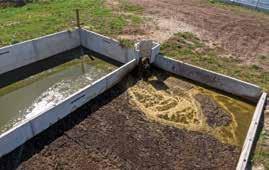

WAIKATO-BASED
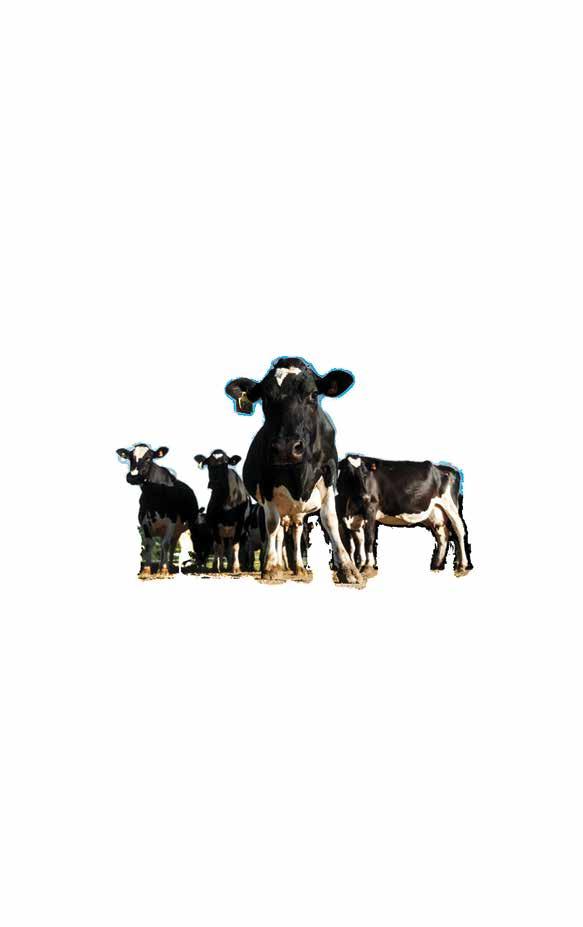

Owner Damian Silvester says they are committed to providing practical solutions to keep businesses running smoothly.
“Our services go well beyond basic electrical work – we are here to solve the problems that can bring a farm to a halt,” he told Dairy News.
The company’s expertise includes setting up and maintaining advanced milking systems, ensuring that every component from the vacuum pump to the rotary platform operates at peak efficiency. This includes upgrading old systems to reduce electricity costs, resulting in reduced downtime, alongside improved milk quality and yield.
“We understand that
“We are here to solve the problems that can bring a farm to a halt.”
every dairy farm is different, so we can tailor solutions to the specific needs of each operation.
“Whether it’s maintaining your existing set up or simplifying plant start-up processes for relief staff so you can get off the farm, or even adapting equipment for your farm’s layout, we bring a deep understanding of dairy farming to every situation. We also can integrate smart technology for remote mon-
itoring and work with HALO Monitoring Systems to provide customised water and effluent management solutions.”
Silvester says downtime on a dairy farm can be costly, so they offer 24/7 service to address issues quickly, which in turn helps ensure milk production continues without interruption.
In the event of a power outage, the company uses its trailermounted CAT generator, “Jenny” to get things back on track.
The company also help farms reduce their energy costs through practical advice and solutions, from upgrading to LED lighting to exploring solar power options for more sustainability.

PPP INDUSTRIES Ltd, established in 1962, is a leading supplier of agricultural equipment in New Zealand.
The company also exports products to over 20 countries.
PPP specialises in dairy shed feed systems for both herringbone and rotary sheds for milking cows, goats, and sheep.
In addition to robust feed systems, the company offers a variety of silo sizes, as well as milling and storage options.
PPP developed & designed and then installed the first in-shed feed system in New Zealand in 1967. Since this first installation PPP have constantly updated systems to meet farmers requirements coupled with advances in technology.
As feed types that farmers use with their in-shed feeding have changed, PPP has developed a system that can easily handle difficult products such as palm kernel expeller (PKE).
Benefits of in-shed feed systems are many.
It saves time: cows are fed whilst being milked. Wastage compared to paddock meal feeding is zero.
It helps mitigate erratic weather patterns and their potential to disrupt pastures and subsequently milk solid production, with a flick of a switch or a pull of a lever.
Animals can receive a nutritious complement of minerals & additives and repairs & maintenance are minimal.
PPP has a large team of agents offering nationwide back up support for service and parts.
PPP also offers a range of silos sizes. PPP has been installing effluent separators since 2002; these systems have been used on dairy and pig farmers, as well as to truck wash stations and the meatworks.
In 2013, PPP began to import and supply to NZ farmers grass and maize silage inoculant.
The inoculant has been developed in the US and, at a very competitive price, it has helped many farmers in the North and South Island.






IN THE ever-evolving landscape of dairy farming, the quest for optimal nutrition is paramount.
For New Zealand dairy farmers, the choice of feed can significantly impact the health and productivity of their herds.
Among the various options available, pelletised dairy rations stand out as a superior choice. In this article we look at why you might consider opting for pellets.
Consistency
Pelletised dairy rations offer a level of consistency that other feed types are hard-pressed to beat. Each pellet is formulated to contain a balanced mix of nutrients, which means that every cow receives exactly the same high-quality diet. This uniformity can go some distance towards
helping maintain the herd health and productivity, as there are no variations in the nutrient intake that could lead to deficiencies or imbalances.
Digestibility
The process of pelletising feed involves grinding the ingredients to a fine powder before compressing them into pellets. This increases the surface area of the feed, making it easier for cows to digest and absorb the nutrients. Improved digestibility means that cows can extract more energy and nutrients from the same amount of feed, leading to better overall health and milk production.
Less waste, easier to handle
Pelletised feeds are also less prone to wastage compared with loose feeds. The compact nature of pellets means

they are less likely to be blown away by the wind or trampled underfoot. This not only ensures that more of the feed is consumed by the cows, but also helps reduce the overall feed costs for farmers. Pelletised dairy rations are also easy to handle and store. They take up less space and
can be stored for long periods without spoiling (provided they are kept dry). In a country with such varied terrain and climate – and the logistical challenges they bring – this convenience is of particular benefit.
Better feed conversion ratios
Studies have shown
that cows fed pelletised rations tend to have better feed conversion ratios. This means they produce more milk per unit of feed consumed compared to cows on alternate feeds. Improved feed efficiency translates to higher profitability for farmers, as they can achieve greater milk
yields without increasing their feed costs.
Precise & eco
Pelletised feeds can also contribute to more sustainable farming practices. The precision in formulation means that there is less likelihood of overfeeding or underfeeding, which can lead to nutrient runoff and envi-
ronmental pollution. By optimising the nutrient intake of cows, farmers can reduce their environmental footprint and promote more sustainable dairy farming practices.
In conclusion, pelletised dairy rations offer numerous advantages over alternate feeds for New Zealand dairy cows. Their consistency, enhanced digestibility, reduced waste, convenience, improved feed efficiency, and environmental benefits make them a superior choice for modern dairy farming. By adopting pelletised feeds, New Zealand dairy farmers can help safeguard the health and productivity of their herds while also promoting sustainable farming practices.
*Article supplied by CopRice @dairy_news facebook.com/dairynews



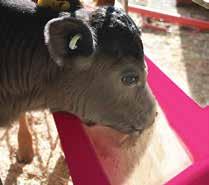





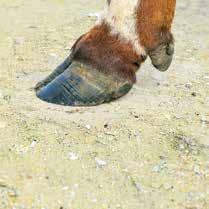

A RISING somatic cell count (SCC) today can mean lower profits tomorrow.
With this season’s payout, this could mean lower milk volumes and higher costs that leave farmers out of pocket.
DairySmart says it uses AI to help farmers tackle mastitis by identifying pathogens, providing precise detection, and sustainable solutions. This reduces economic pressures and improves herd health, enhancing farmers’ bottom lines.
In New Zealand, the annual cost of this disease is estimated to exceed $200 million, while globally, it surpasses $35 billion. The extensive use of antibiotics increases economic costs and raises concerns about antibiotic resistance, leading to regulatory changes in many countries.
The global industry has put in measures to combat antimicrobial resistance (AMR). Last year, over 1 million lives were lost due to AMR-resistant bacteria - projected to rise to 10 million deaths/year by 2050.
In New Zealand, the discovery of antibioticresistant bacteria Staph aureus (MRSA) in several dairy herds highlights the urgent need for rigorous testing of milk to identify resistant bacteria. It’s essential that we accu-
rately test cows to mitigate the risk of spreading these pathogens in our herds.
DairySmart received the NZPI Technology Innovation Award in 2023 and says it continues to make progress in a competitive landscape with its precise diagnostics and user-friendly reporting for farmers and veterinarians.
The company follows an evidence-based approach, and says independent testing confirms it has market-leading accuracy.
DairySmart’s userfriendly technology has been attractive to European veterinary clinics and their farmers due to mandatory reductions in antibiotic usage; with similar regulations anticipated for New Zealand.
The company says European clinics often prefer DairySmart’s solutions, citing “enhanced speed, comprehensive reporting, and improved accuracy as key factors in their transition from other products”.
It says an independent scientific review found that DairySmart’s SmartScreen before autumn dry-off effectively treats infections while significantly reducing antibiotics. “This supports sustainable farming and offers economic benefits.
Some farmers have seen a 90% reduction in antibiotic use, 55% less mas-
titis, and $30 extra per cow from savings and increased milk production with DairySmart.
“DairySmart’s patented aseptic milk sampling technology facilitates rapid and precise pathogen testing, extending beyond mastitis detection. This technology has led to a notable increase in demand for Johnes testing.”
As DairySmart grows, it says it remains committed to advancing agricultural technology and promoting responsible farming practices through on-farm support and innovation. The company aspires to lead in on-farm pathogen diagnostics and support.
Ben Davidson is the CEO and veterinary advisor. The company is increasing its operations in New Zealand and meeting demand from British and various European markets. It offers services to clients in over 12 countries, including Netherlands, Norway, and Ukraine.
The DairySmart board is implementing steps to manage this expansion, describing it as a “great challenge to be facing.” Their successful capital raise is nearing its target, which will be used to enhance DairySmart’s artificial intelligence capabilities towards achieving 99% accuracy and expand their diagnostic services.




BLUE PACIFIC Minerals
is a well-established New Zealand-owned company based in the heart of the South Waikato, Tokoroa.
The company is proud to serve the agricul-
tural community with a wide range of products designed to promote the health and productivity of animals and crops.
At the core of the business is zeolite, a
remarkable natural mineral that Blue Pacific mines and processes right here in South Waikato.
Zeolite has earned its reputation as a trusted component in many agricultural solutions due to its unique properties, including its ability to bind toxins and enhance nutrient absorption.
“Our commitment to processing this min-



A DairySmart Smart Screen at dry-off will identify which of your cows have bacteria in their udders, and which species are the problem to address Fast turn around- with every cow’s results detailed
Comprehensive report to take the right actions for each cow
Identify all Staph.aureus cows and stop the spread next season
Only treat cows that need it, use less antibiotics & save money
Start next season with confidence knowing your herd is clean
NOW FOR EARLY BIRD DISCOUNT

eral locally ensures that we maintain the highest quality standards while supporting our regional economy,” the company says.
“Our product range includes well-known names like OptiCalf and Optimate. Optimate is a standout herd feed supplement, featuring ACVM approval as a toxin binder.
“This product combines zeolite with probiotics and essential minerals to deliver a comprehensive nutritional solution for livestock. Designed to support peak health and performance, Optimate has become a trusted choice for farmers looking to improve the well-being of their herds.”
the soil with vital trace elements and minerals.
With a focus on sustainability, their liquid fertilisers enable farmers to use fewer units of nitrogen, achieve precision application, and incorporate essential nutrients tailored to their specific soil needs.
This approach not only supports healthier crops but also contributes to better environmental outcomes.
peak condition, ensuring they perform at their best.
“Blue Pacific Minerals is committed to supporting New Zealand farmers by providing effective solutions that enhance animal health, improve soil fertility, and boost productivity. Our dedication to innovation and quality has made us a trusted partner in the agricultural sector.
See
Learn

In addition to feed supplements, Blue Pacific Minerals also offers an innovative range of liquid fertilisers. These products are formulated to enhance crop and pasture growth while replenishing
One of Blue Pacific’s unique offerings is Stock Rock, a race rock specifically designed to eliminate stone bruising and provide safe, comfortable pathways for cows heading to the farm dairy. By promoting faster and safer movement, Stock Rock helps to enhance overall productivity and reduce animal stress, says the company.
“We also cater to the equine industry with a range of products developed to keep horses in
“We invite you to learn more about our products and their benefits by visiting our stand at the Dairy Expo.
“Whether you’re interested in improving herd health with our feed supplements, optimising pasture growth with our liquid fertilisers, or exploring solutions like Stock Rock for better farm infrastructure, our team is ready to assist you. Together, we can help your farm achieve peak performance and sustainability.”





SMAXTEC’S BOLUS
technology supports early detection of potential diseases, enabling preventive measures to improve herd health and reproductive outcomes.
smaXtec says the bolus provides precise insights directly from within the cow, operating reliably inside the reticulum – unlike external sensors, which can be easily affected by environmental factors, especially in grazing systems. It measures inner body temperature with unrivalled accuracy (±0.01°C), tracks water intake, drinking cycles, rumination based on reticulum contractions, and overall activity. This precise data enables the earliest possible detection of potential diseases, long before visible symptoms appear, by instantly alerting farmers via smart-
phone or computer for timely intervention.
Focus on prevention
David Thompson, who runs a 305-cow farm in Feilding, ManawatūWhanganui, says he received three temperature alerts over three days.
“The vet confirmed pneumonia, even though the cow appeared fine. Without smaXtec, I wouldn’t have noticed it until 3-4 days later.”
Sarah Neilson from South Taranaki, managing a herd of 340 cows, adds that it’s been about prevention rather than cure.
“When we had a case of twisted bowel, we caught it early. It had just started when we were able to get the vet to remedy it.
“He had the thermometer in the cow and said, ‘I will never have

• Let Goodwood sort your animal bedding this season
• Bonnie the Cow Animal Bedding and Herd Shelter Stand-Off Pad readily available, as well as Animal Bedding for Compost Barns
• Product available across Waikato, BOP, and Central Plateau
• Delivered direct to you, when you need it
• Made using 100% recycled untreated timber for the health and comfort of your herd




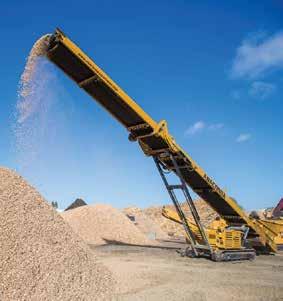

to deal with that ever again—this is such reliable data.’ Now, the vet checks the smaXtec data first because the temperature alerts are always accurate.”
Supporting productivity and profitability
The company says early detection with smaXtec allows for milder treatments and reduces the need for antibiot-
ics, which can help lower treatment costs and support stable milk yields. The system also provides insights that enhance heat detection, support reproduction and conception rates, and optimise the calving and mating process.
Hayden Lawrence, who runs a 430-cow farm in Taranaki, observes: “Using smaXtec has
improved heat detection, reduced mastitis cases by 64%, and cut costs by 56%. It has become an essential part of our routine, saving us time by reviewing health data before each milking.”
For more information visit their website www. smaxtec.com/en/new-zealand/ or contact via info@ smaxtec.com.
TO MARK International
Day of Education on January 24, 2025, state farmer Pāmu (Landcorp) announced the commencement of its Apprenticeship Scheme, designed to equip the next generation of farmers with the skills, knowledge, and experience needed for a thriving career in agriculture.
The nine apprentices, many of whom were in high school just last year, have begun settling into farm life over the past two weeks of onboarding at Aratiatia Farm in the Central North Island. Donning their high-vis uniforms and work boots, the apprentices from diverse backgrounds and geographies, are adjusting to their new roles.
The first cohort of

apprentices brings a wealth of enthusiasm and aspirations to the programme. From aspiring head shepherds to future farm owners, each apprentice is eager to learn, contribute, and grow.
The scheme offers apprentices a unique opportunity to gain hands-on experience in both dairy and livestock
farming while working toward Level 3 and 4 Primary ITO qualifications.
Apprentices will gain practical skills including animal husbandry, stock rotation, pasture management, and vehicle operation.
The first year offers a broad foundation before apprentices specialise in either dairy or livestock in their second year, with
a guaranteed permanent role at Pāmu upon completion.
Carl Carmichael, farm manager at Aratiatia and a dedicated mentor to the apprentices, emphasises the importance of supporting young people in the agricultural sector.
“It’s incredibly rewarding to guide young farmers as they find their feet in the industry.
Watching them grow and develop into confident, skilled individuals is what it’s all about,” says Carmichael.
Supporting the apprentices is Gary Brady, Pāmu apprenticeship scheme manager, who brings decades of experience in agriculture, education, and mentoring.
“For me, it’s about building confidence and
self-belief in these young people. This programme isn’t just about farming— it’s about helping them develop as individuals,” he explains.
“We’re preparing these apprentices not just for a job but for a lifetime of farming excellence. It’s about respecting the land, embracing innovation, and leaving a legacy for future generations.”
Pāmu chief executive Mark Leslie says: “As the apprentices embark on their journey, we look forward to the long-term impact this programme will have on New Zealand’s agricultural future. By investing in young talent, Pāmu is building a stronger, more resilient industry that prioritises innovation, sustainability, and community.”
The apprenticeship scheme aligns with commitment of Pāmu to sustainable progress, supported by the ASB Sustainable Progress Initiatives. This $1 million partnership funds innovative industry-good projects, including methane reduction research, smart agri-data tools, and the Pāmu Apprenticeship Scheme.
Pāmu is the brand name for Landcorp Farming Limited, a stateowned enterprise with 112 farms across the country. Pāmu exists to enhance the future of agriculture for generations and is focused on running a profitable and efficient business where farming activities positively impact ecosystems and communities.
ZARA WILLIAMS’ personal and professional growth has seen her presented with the top award at the 2025 World Wide Sires national all dairy breeds youth camp.
The 17-year-old from Palmerston North was presented with the Paramount Cup – awarded to the top allrounder – at the conclusion of the Youth Camp, held in Wyndham from January 4-7. She was also presented with the title of top senior handler.
Holstein Friesian NZ field officer and youth camp co-ordinator Amelia Griffin said she was impressed with the level of growth and development
Zara had demonstrated over the past three years she had attended Youth Camp.
“Over the last few years Zara has shown growth – not only within herself, but in her ability to work with others, particularly younger kids,” Griffin said. “She is such an incredible young woman.”
Each year Holstein Friesian NZ hosts the youth camp, which is designed to upskill young people aged 10-21 interested in showing and handling dairy cattle.
Held over four days, the camp allows young people to make friends,
learn about animal behaviour and care and take part in a mini show and team building activities. Educational modules at the 2025 youth camp included showmanship and clipping modules, a reproduction module with Vytelle and a technology module with SmaXtec.
Each year six awards are presented at the conclusion of the youth camp: top junior handler, top senior handler, the McDonald Family Trophy for best presented heifer, the Dennis Terry Memorial Trophy for most improved clipper, the best team award, and the Paramount Cup for best all-rounder.
This year, judge Clint Cummings
presented the top junior handler to Elyse Horgan (13) of Palmerston North; the McDonald Family Trophy for best presented heifer to Lucy O’Reilly (15) of Tirau, and the Dennis Terry Memorial Trophy for most improved clipper to Nishaan Bindra (13) of Morrinsville. The best team title went to the SmaXtec team.
Griffin said Zara not only stood out to those running the camp, but to the judge as well.
“She is always eager to help, jumping in whenever she is needed to assist in leading and clipping,” she says.
“Her skill level has also grown; she
asks questions whenever she needs to and takes everything we tell her on board.”
Griffin said the heifer that was assigned to Zara at the beginning of the youth camp wasn’t easy, and she experienced some setbacks along the course of the camp.
“But she managed to turn it all around. She not only placed first in her team for the best presented heifer, and third overall, but was presented with the title of top senior handler and top all rounder.”
Griffin said the 2025 camp was a fantastic event.

THE OPENING of Bovonic’s new facility near Tauranga late last year will allow the company to commercialise the production of its mastitis detection technology, QuadSense, to meet farmer demand and support plans for international expansion.
The company will be keeping product assembly in-house, allowing it to uphold stringent quality control and achieve significant cost savings, so it can continue offering an affordable price point for farmers.
QuadSense was officially launched at National Fieldays in June last year. In just 6 months, more than 1,000 units have been installed on New Zealand dairy farms, delivering immediate benefits such as reduced bulk somatic cell counts, improved herd health, and time savings for farmers.
With this strong foundation at home, Bovonic is now preparing for a UK and Ireland market launch. The company has already established trial farms in Ireland and received positive feedback from international trade shows, validating QuadSense for overseas markets.
“Keeping our final assembly in-house has been a game-changer,” says Bovonic founder
QUADSENSE IS made up of four patented milk sensors that are inserted into the four liners of the milking cups. By measuring and comparing milk from each quarter of the udder, QuadSense can achieve greater accuracy than other in-line mastitis detectors.
QuadSense starts measuring milk as soon as the cups are on, then gives a result after just a minute. It can be installed by farmers into any milking cup liner and gives a red-light alert when mastitis is present.
DairyNZ estimates the cost of mastitis across the New Zealand dairy industry is $180 million per year.
Liam Kampshof.
“It allows us to maintain absolute control over product quality, which has always been our top priority. And these are also the first premises we’ve had with windows – natural light makes a big difference after spending years tinkering away in dark sheds!”
Kampshof dreamed of becoming an inventor from the age of eight. Celebrating this milestone has been an opportunity for him to reflect on how far Bovonic has come since its inception in 2021.
“I started with a prototype made from a Bunnings pipe and a 3D-printed sensor,” he says.
“We tested the concept at Fieldays and had 150 farmers sign up, saying they’d buy something like this if it existed. That early validation
gave us the confidence to move forward - and here we are, a few years later, with over 1,000 units installed.”
Farmer feedback has been integral to Bovonic’s success, shaping
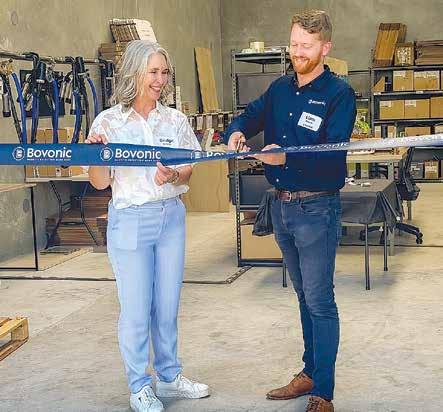
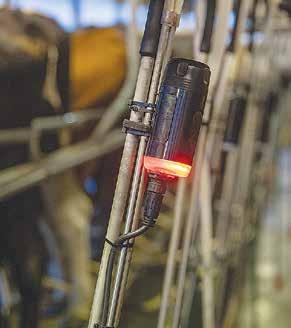
the development of the QuadSense system and
its app.
“Initially, we didn’t plan on creating an app,”
Kampshof admits. “But farmers told us they needed easier ways to track alerts and adjust thresholds, so we created a tool that makes recordkeeping seamless and improves usability.”
A $940,000 capital investment last year has supported QuadSense’s launch, product development, IP protection, and exploration of overseas markets. The company says the technology has transformed mastitis management, offering farmers peace of mind and tangible results.
“One farmer told us he found 15 staph cases in just one month using
QuadSense,” says Kampshof. “That level of early detection not only saved his herd, but also reduced his stress and prevented the spread of harsh, contagious strains of mastitis.”
Bovonic’s next steps include setting up a New Zealand distribution network, validating QuadSense for rotary sheds, and continuing international trials ahead of its UK and Ireland launch.
To support this growth, immediate hires include a product development lead to drive innovation and a customer success representative to enhance
It’s been a huge part of our growth, and I’m incredibly grateful to my team and investors for believing in our vision.”
farmer support.
“The best decision I’ve made was hiring people who are smarter than me,” says Kampshof. “It’s been a huge part of our growth, and I’m incredibly grateful to my team and investors for believing in our vision.”
Bovonic says it is committed to improving animal health, farm profitability, and environmental outcomes. It says QuadSense reduces the need for antibiotics, helps lower somatic cell counts, and aligns with the dairy industry’s emissions reduction goals.
“This milestone is just the beginning,” says Kampshof.
“Our vision is to make QuadSense as indispensable to dairy farmers as automatic cup removers. It’s about creating technology that’s simple, affordable, and truly valuable for farmers.”

ONE NZ Satellite TXT
initial service was rolled out to customers on eligible phones and plans at no extra cost last month.
The company says this will deliver mobile coverage like never before, where people have clear line of sight to the sky.
Joe Goddard, experience & commercial director at One NZ, says, “We have lift-off! I’m incredibly proud that One NZ is the first telecommunications company globally to launch a nationwide Starlink Direct to Mobile service, and One NZ customers are among the first in the world to begin using this groundbreaking technology.
“We’ve worked with Starlink to provide coverage across Aotearoa, including to the around

TO SHOWCASE the potential of this technology, Sir Edmund Hillary’s grandson, George Hillary has conducted another significant test of the One NZ Satellite TXT service, giving it his seal of approval.
With a clear line of sight to the sky, he sent a message to his brother Alex Hillary, general manager of the Himalayan Trust, from the top of Mount Head, one of the most remote peaks in the Forbes Mountains in Otago.
George Hillary says, “The potential of this technology is mind-blowing. I’m used to being pretty limited from a communications perspective when hiking or on an adventure. I always take an emergency beacon in case things go wrong, but now also having the ability to send and receive text messages is huge. I can contact a friend for help or give climbing updates to my family while away.
“And if you’re wondering what the
text said – I went with the line ‘Knocked another milestone off! Made it up safe’.”
Goddard explains: “Talk about peak coverage! With Earth’s horizon in reaching distance, Sir Edmund Hillary’s mountaineering grandson George Hillary is proving the sky is not the limit on One NZ’s satellite to mobile service. He put our initial satellite service through another test, at an altitude of 8,480ft – a text, quite literally, sent from the middle of nowhere.
“It’s important to note that the One NZ Satellite TXT service is not a replacement for existing emergency tools, and instead adds another communication option.”
As part of the launch, One NZ is donating to the Himalayan Trust, founded by Sir Edmund and Louise Hillary to inspire New Zealanders to support those living in another remote part of the world, the Everest region of Nepal.
40% of NZ’s landmass that is not covered by traditional mobile networks – plus approximately 20 kilometres out to sea.
“Right from the start we’ve said we would keep customers updated with our progress to launch in 2024 and as the technology develops. Today is a significant milestone in that journey.”
Eligible customers with a Samsung Galaxy Z Flip6, Samsung Galaxy Z Fold6, Samsung Galaxy S24 Ultra, and OPPO Find X8 Pro will be contacted directly to let them know they can start using One NZ Satellite from – with the list of eligible phones set to expand throughout
2025. Current consumer Pay Monthly plans will include One NZ Satellite TXT for no extra charge, including Companion Group Plans, and current Endless Business mobile plans.
“We continue to test the capabilities of One NZ Satellite TXT, and this is an initial service that will get better,” says Goddard.
“For example, text messages will take longer to send but will get quicker over time. We’re beginning with small number of phones as part of the staggered rollout of the technology.
“And critically, from today customers can send and receive text messages
THE ONE NZ Satellite TXT service is being delivered in partnership with Starlink Direct to Mobile, which is engineered by SpaceX.
SpaceX is leveraging its experience in manufacturing and launching the world’s most advanced rockets and spacecraft to deploy Starlink satellites with the Direct to Cell capability at scale.
This is trailblazing technology that covers dead zones, and One NZ is one of a handful of telecommunications companies globally who has signed up to offer this service to customers, at no cost to the taxpayer.
“For New Zealanders who like getting out into our great outdoors – or for people who need to travel along state highways and beyond for work – the reality is that many parts of the country lack traditional mobile coverage,” says Joe Goddard.
“The list of eligible phones will start with four handsets at launch and expand soon as we continue our extensive testing. Our teams continue to test the service on additional phones, and we expect hundreds of thousands of customers to be able to use One NZ Satellite TXT by the end of 2025.”
only, but in the future, we expect voice calling and data to also be available.”
One NZ testing indicates in many cases during the initial rollout period, text messages will be sent and received within 3 minutes. However, at times it may take 10 minutes or longer to send and receive a text message via satellite, especially during the first few months. As the service matures and more satellites are launched, we expect text messages to take a minute on average to be delivered via space.
“This is a generational change in mobile technology, just like 4G or 5G. Not only will you be able to message family and friends from parts of our beautiful country
that you never thought possible, but soon this will open up new opportunities in IoT (Internet of Things) for sectors like agriculture, tourism, logistics and many more that power our economy here in NZ.
“Furthermore, One NZ Satellite TXT has the potential to provide another layer of resilience in public emergencies when traditional mobile and fixed networks are affected, like what happened during Cyclone Gabrielle,” adds Goddard.
“This is still emerging technology, but T-Mobile US tested some of its capabilities during Hurricane Milton in October, which is the only other time this technology has been opened up to customers so far.”



GEA FARM Technologies
New Zealand is announcing the launch of its cutting-edge Automatic Milking Systems (AMS), designed to bring a new level of efficiency, profitability, and sustainability to pasture-based dairy farming.
“This technology is brand new to New Zealand,” says Craig Lowry, head of sales & service at GEA Farm Technologies New Zealand.
“This innovative range, tailored for farms of all sizes, combines advanced automation with traditional farming practices to meet the unique needs of Kiwi farmers.”
With options for both voluntary milking systems (cow-led, 24/7 operation) and batch milking systems (scheduled group milking), GEA’s AMS offers flexibility and adaptability for farms looking to modernise without compromising their heritage.
“This is so important, the dairy products our farmers produce are trusted worldwide because of New Zealand’s farming heritage, we want to modernise while staying true to what makes us
large-scale operation. Their advanced milking stall modules featuring the original DairyRobot R9500 voluntary robot, the DairyProQ rotary, and the all-new R9600 and R9650 boxes for batch milking, are designed to grow alongside a farm’s evolving needs.
“Automatic batch milking is gaining momentum in New Zealand, particularly for herds over 300 cows, says Lowry.
“Batch milking mirrors conventional milking routines but leverages automation to optimise labour, streamline cow traffic, and ensure high throughput. For farmers







future of dairy farming without losing the essence of what makes their operations unique. By combining automation with pasture-based principles, we’re offering tools that increase efficiency and sustainability while keeping farmers in control,” says Lowry.
mated rotary system capable of milking up to 600 cows per hour, equipped with individual robots at every milking point.
■ DairyRobot R9500ideal for smaller herds, offering the flexibility of voluntary milking.
GEA’s In-Liner Everything technology revolutionises the milking process by combining all essential steps, including teat stimulation, cleaning, milking, teat spraying, and cluster rinsing in
GEA’s AMS has already delivered significant results across Australia. The Krichauff family in South Australia reported increased milk production, better animal health, and enhanced labour efficiency after adopting three DairyRobot R9500 units in a voluntary environment. Meanwhile, the Smith family in Victoria saw dramatic improvements in milking efficiency and cow behaviour after adopting batch milking through the DairyProQ robotic rotary.
GEA says it is bringing a new era of dairy farming to New Zealand. Committed to equipping New Zealand’s dairy farmers with tools to meet the challenges of modern farming while maintaining the principles that define their industry. Farmers can expect to


smaXtec’s unique bolus technology helps detect potential diseases early, enabling preventive action to improve health and reproduction outcomes.
smaXtec customer
Hayden Lawrence


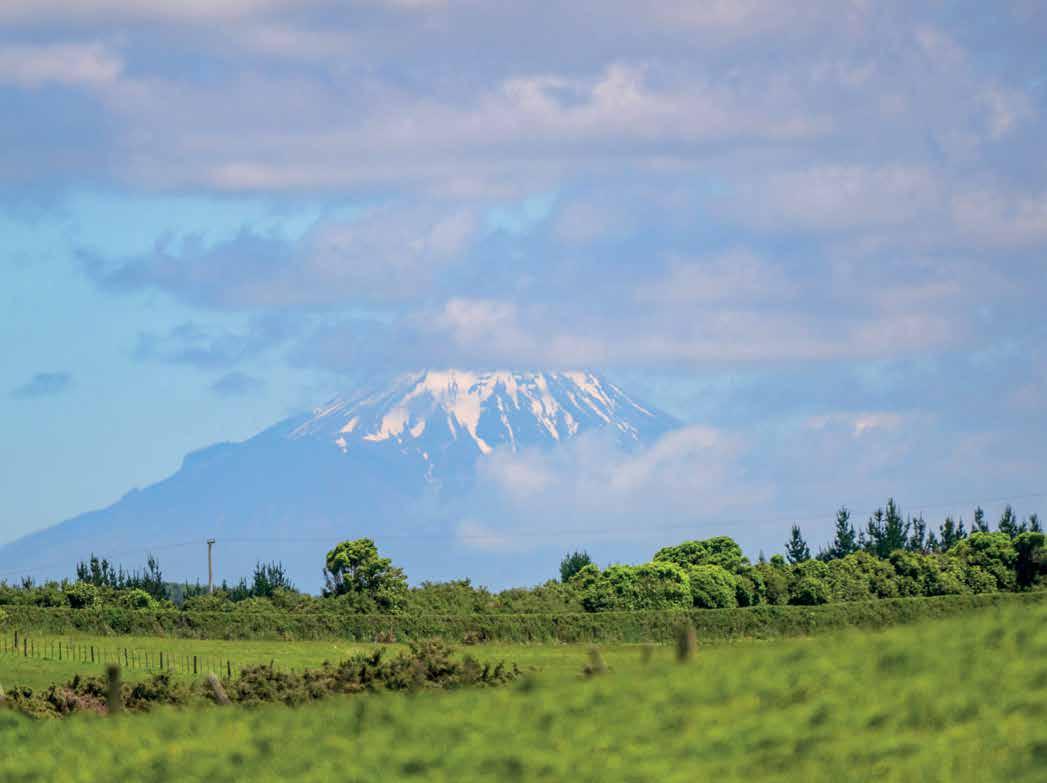
Unlike traditional monitoring systems, smaXtec provides accurate insights from within your cow. A bolus in the reticulum collects data on inner body temperature, drinking cycles, water intake, rumination, and activity, sending actionable alerts to your smartphone or PC.

This data helps detect potential diseases before visible symptoms appear, enabling early intervention, reducing treatment costs, maintaining stable milk yields, and boosting profitability. With smaXtec you can also enhance heat detection, boost reproduction rates and optimise the calving process.
smaXtec has already made a difference for many dairy farmers. Hayden Lawrence, who runs a 430-cow farm in Taranaki, reports:
“Using smaXtec has improved heat detection, reduced mastitis cases by 64%, and cut costs by 56%. It also helped manage calving, calf health, and fresh calvers. We spend five minutes reviewing the data trends for heat, sickness, and health before each milking, saving us time and becoming a key part of our daily routine.”
Jeff
Sales Country Manager jeff.hill@smaXtec.com +64 210 38 57 03

WAIKATO DAIRY farmers are well-placed heading into the peak of summer, thanks to favourable growing conditions late last year that resulted in abundant onfarm feed reserves.
However, with warmer, more humid days ahead, SealesWinslow national sales manager Ryan Scholes advises farmers to focus on balancing cow diets and making strategic feeding decisions to keep cows in milk and maximise the strong forecast payout.
“Many farmers have more surplus feed, like grass silage, than they’ve had in recent years due to excellent pre-Christmas growth,” he says. “While this puts them in a good position, it’s important to remember that summer grass can become fibrous, so balancing the diet with more digestible feed is key to maintaining milk production.”
The importance of balanced diets
Farmers feeding fibrous grass silage or older pasture should consider supplementing with a low NDF (neutral detergent fibre) feed that is easier to digest and promotes efficient rumen function. According to Scholes, a feed with a good mix of protein and starch is critical.


Feeding fibrous silage alongside feed that doesn’t digest quickly, it can limit rumen efficiency, he says. “Instead, opt for a feed that ferments well in the rumen, has high metabolic energy (ME), and is compact and concentrated for easy consumption.”
This advice becomes even more critical as the hotter, more humid months approach.
“To maintain rumen efficiency and support milk production, every bite of feed needs to count.”
Managing heat and
With the heat and humidity rising, cows expend significant energy trying to stay cool, often leading to reduced feed intake. Providing compact, high-ME feeds that cows can consume easily and efficiently during these challenging conditions is essential.
“When cows eat less in the heat, you need feeds that deliver high energy in a small package,” he says.
Transitioning to OAD
Many farmers are also starting to think about transitioning to once-a-
day (OAD) milking. This change can help preserve body condition and reduce stress on cows during the hot, humid months. However, Scholes cautions farmers to ensure there’s suitable feed available in the shed to maintain milk production.
“Having something easily digestible and high in energy is critical for cows on OAD milking. It’s about keeping them productive while preserving their condition for the next season,” he says. Keeping cows in milk longer
With no more advance payments for Fonterra farmers, Scholes advises them to keep their cows in milk as long as possible to maintain a steady income stream while preparing for the next season.
“Keeping cows in milk longer ensures you’re getting the best return on this season’s payout while maintaining their condition. It’s a balancing act between getting production now and setting yourself up for a strong start to the next season.” For more tailored advice on balancing cow diets and maximising milk production, visit the SealesWinslow team on Row C: Site 102 at the Dairy Expo.

With our 24/7 emergency refrigeration service, you can count on DTS to protect your production. For more than seven decades, we’ve been helping dairy farmers achieve excellence in milk quality.
WAIKATO FARMER Dave Muggeridge was fed up with water seeping in through his maize silage cover and spoiling feed.
About 17.5ha of maize is planted on the farm and around 350 tonnes of maize harvested and stored in a bunker as feed for 330 Friesian cross cows.
He came across an article on GeoSmart Eco Silage covers and decided to attend an environment field day where the product was being exhibited. He liked what he saw and started using GeoSmart Eco Silage covers in March last year.
He told Dairy News that the covers have reduced the wastage from 10% to 3% by just preventing holes that let water and air in.
“They are much easier to cover the stack with,”
he says.
“We don’t need to put tyres all over the stack: you do not need as much labour to put the covers on.
“By investing in GeoSmart silage covers we have ensured that every bit of maize silage is utilised and of good quality. We have less wastage, the covers are easy to use and good for the environment as they are reusable for many years.”
Muggeridge is building a new silage bunker and will be using GeoSmart Silage covers.
Also a Tatua shareholder and director, Muggeridge owns 141ha (135ha eff) that produces around 137,000 kgMS. It is run by contract milkers.
The farm also grows 11ha of chicory, used to feed cows from late December until May 1.
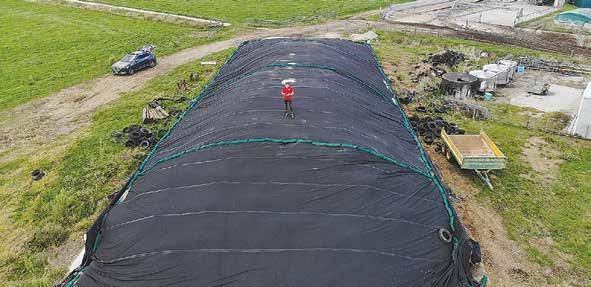




of dairy farming centre around looking after animals well, and a whole bunch of logistics –largely lifting and loading. Typically, this might be shifting fertiliser in to store and out of store into a spreader, stacking bales or bulk silage and loader feeder or mixer wagons. While tractors and front-end loaders are still in widespread use, many farmers are coming to realise the value of adding a telehandler to their operation.
The German-built Kramer telehandler range is an important part of the Brandt product, with a range of models available, including the KT144, KT276, KT307, KT407 and KT457, which collectively offer load capacities from 1.4 to 4.5 tonnes, with lift heights from 4m to 7m.
One model finding favour with dairy farmers is the KT276, featuring compact dimensions of less than 2m in width and height, but nonetheless packing plenty of performance. As the numbers suggest, the 276 offers a maximum lift capacity of 2.7 tonnes at ground level and the ability to lift 1.8t to the maximum lift height of 5.73m.
Particularly suited to working in and around the yards, especially areas with tight access, recent upgrades to the KT276 have added greater


sophistication to match its larger siblings, being the first in Kramer’s telehandler line-up to offer the option of Smart Attach, an automated attachment changeover system. This is very useful if daily operations include changes between forks, buckets, grabs or bale handlers, making switches fast and safe.
Focusing on the compact dimensions, a choice of height is provided by two cab mounting options. In low-cab guise, the machine stands just 1.98m tall, so is the better choice if access through a low opening is critical; alternatively, the standard cab sits at 2.1m.
Power comes from a 55kW (75hp) Kohler
diesel engine mated to a three-range fully hydrostatic transmission that propels the KT276 to a top speed of 30km/h or 40km/h option. Standard spec includes a selectable two or four-wheel drive system and front, rear and crab selectable steering modes.
As well as a 103-litre/ min gear pump with loadindependent flow-rate distribution hydraulics, engineers have improved productivity by relieving the operator of needing to set a precise bucket or fork angle after it has been dumped. This function joins existing automated controls, including the vertical lift mode that extends the boom’s telescopic section as it is
raised and retracts it as the boom is lowered.
The Smart Attach, quick attachment changeover system, sees oil passing through one of the locking pins, so attachments using a third service can still be coupled without the operator needing to leave the cab.
Further automation sees as standard three functional modes of bucket, stacking, and manual – all easily managed through the ergonomic joystick.
On the safety side is a Smart Handling overload protection system that helps to keep everything under control in all high reach or loading situations to prevent overloading, and further eliminates the chance of the machine overturning, while also handling many routine tasks.
The Kramer cab offers plenty of head and legroom, low noise levels and a comfortable seating position, while clever ergonomics sees all control positioned with quick access to the most frequently used functions, with switches labelled by colour according to functional groups.
All machine information for the machine is readily available on the display, while also providing access to optional functions, including joystick sensitivity and return to angle adjustment.
Visit Brandt at site number 15.
@dairy_news
facebook.com/dairynews


FARM RACES or lane-
ways are central to moving animals, people and machinery around the farm. In the case of dairy farms, their maintenance is paramount as cows may walk considerable distances two or even three times a day.
Ideally, races need to have a slight crown in the centre that slopes away to either side, allowing surface water to drain away freely, helping to reduce the formation of holes and mud.
Over time, the preferred track of animals moving in a procession can mean the build-up of “berms” or ridges along the sides of the race, meaning water is stopped from draining.
Typically, races are maintained and reprofiled using tracked excavators to remove the build-up of material at the side of the race, which needs to be hauled away with a tractor and trailer. Research suggests that this process is relatively slow, with the machines typically able to remove around 125 metres of build-up per hour, with a rate for the machine and driver at around $225/hour.
Back in 2021, Hast-

ings-based Landquip were displaying a range of products for horticulture at the Mystery Creek Fieldays, one of which was a sweeper designed to move orchard prunings. Several dairy farmers and contractors asked if the orchard sweeper could be used for cleaning the edges of dairy races or laneways.
Fast forward to 2024, Landquip put their thinking caps on and came up with a solution.
Built in Hawke’s Bay, the Lanerotr R1 quickly removes the soil and grass build-ups along the edges of races to restore drainage, leading to a drier surface and a reduction in lameness.
The manufacturer sug-
gests operating at around 1 to1.5km/h it’s easy to restore up to 5km races during a working day. A 5-minute set-up time means it is easy to fit the machine during a busy day or even between milkings. Mounted on a front-end loader, using standard Euro quickhitch couplings, a robust frame carries the clearing
rotor, offset to the righthand side of the tractor. The operating height is maintained via a wheeled under-carriage, with the loader in the float position to ensure the unit follows any undulating contours.
The frame incorporates an integral breakaway pivot if the scraper paddles encounter any
immovable objects, while the rotor motor is also equipped with hydraulic overload protection.
Said to be suited to a tractor with minimum 90hp, with 60 litres/ minute hydraulic oil flow, the loader will require a third service function, with a detent function to maintain constant flow to the rotor.
Offered with a 2-year warranty, the R1 features a minimum number of wearing parts, while offering the ability to restore up to 750 metres of race edges per hour, with a typical cost of $150/km, compared to a more traditional method that would run to $1,800/ km.
www.landquip.co.nz

Made in New Zealand is a feature that looks at the wealth of design and manufacturing ability we have in New Zealand, producing productive and cost-effective products for the agricultural sector. Machinery and Products editor Mark Daniel takes a closer look at Combi Clamp Limited, catching up with Managing Director, Wayne Coffey.
Q- When was the company founded, by whom and why (was it to solve a problem or market a product)?
The company was founded in 2002 by me and my wife Lynley while managing a farm in Taihape. With 11,000 ewes and a sheep handler the sheep didn’t like, we realised we needed something more user and stock friendly.
Q- Where are you locatedis it single or multiple sites and how many people are employed?
In 2017, we purchased
our workshop in Palmerston North, where we currently employ six full time staff, including two sales representatives who cover New Zealand and Australia. We also have an agreement with Ritchie Agricultural, based in Scotland, who manufacture and sell the Combi Clamp under licence.
Q- What are your key products and which markets do they serve?
Our range includes the Combi Clamp Sheep Handler that offers a range of options includ-

ing 3-way Drafting, Weighing, Gadget Holders, Races, Wheel Attachments, Wool Classing and Lamb Cushion Walls. Our range of cattle crushes are aimed at general, heavy-duty and vet operations, with options including Auto Head Yoke, Sliding Gate, Anti Backing Ratchets and Offside Gate Openers.
Q- Are your products unique - if so, what are the

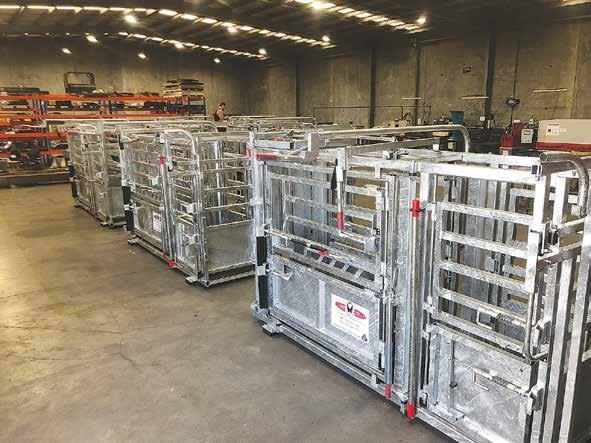
four key benefits? If not unique, what are the four unique selling points?
The Combi Clamp is unique because it catches sheep with the operators’ body weight being the mode of power. It is quiet because there are no power-driven air or hydraulics, meaning there’s nothing to go wrong, so maintenance is minimal. The HD Cattle Crushes follow the same principles, all featuring our Auto Head Yoke, where cattle catch themselves.
Q- Looking at an ever-evolving market, what changes have you made over the last few years?
The world has become a throwaway society,
but living with a wife who thinks everything should last 30 years, we keep building equipment stronger to handle bigger animals.
Q- What has been the company’s greatest success since its formation?
Our greatest success is measured by the positive client feedback that we receive. We have sold thousands of handling systems in the UK, EU, Ireland, Canada, North America, Australia, and NZ.
Q- In contrast, what has been the biggest “Oh Bugger” moment or the steepest learning curve?
Our biggest learning curve was that we should have moved to inhouse manufacturing ear-
lier than we actually did. Manufacture by a third party meant margins were too tight to grow the business. Keeping things in-house means we can make changes more easily and work on R&D with new product development.
Q- If you were approached by someone looking to start a business, what would be your three key pieces of advice?
Do your research and develop your product before hitting the market to be in front with momentum. Believe in and back yourself because if you aren’t confident you may end up a statistic and finally, it’s all about the people not the product.

TAUPO BASED lowcarbon dairy company
Miraka has its sights set on using 100% renewable energy in the next decade.
The dairy processor, New Zealand’s second largest Māori-owned global export company, was the world’s first company to use renewable geothermal energy in dairy processing.
Chief executive Karl Gradon says Miraka has always set lofty goals, and has set its sights on being fully powered by renewable energy in line with its core value, kaitiakitanga – caring for the natural environment and
resources.
“We aspire to be 100% powered by renewable energy come 2030. Ninety three percent of our current energy already comes from renewable energy sources such as geothermal, so we are already most of the way there,” he says.
Last September, Miraka launched New Zealand’s first green hydrogen dual fuel powered milk collection tanker.
The 700 horsepower Volvo hydrogen-diesel tanker reduces on road carbon emissions by 35% per tanker which is the equivalent carbon reduc-

tion benefit of planting 1,600 trees annually.
“We’ve embraced innovation, another of our core values, to introduce green hydro-
gen into our operations and supply chain,” says Gradon.
“This move has taken us a major step closer toward our aspirations of
being fully powered by renewable energy. Any initiative which removes carbon emissions from the atmosphere is a good initiative.”
The hydrogen is produced by Halcyon Power, a joint-venture of Obayashi Corporation of Japan and Tūaropaki Trust, a foundational shareholder in Miraka with its roots in the settlement of Mokai, 30km northwest of Taupō. The hydrogen plant is nearby to the Miraka dairy plant which also calls Mokai home.
The geothermal steam power which Miraka uses is also owned by Tūaropaki Trust. The steam is piped across the road from the Mokai Power Station to the Miraka plant. The remaining power goes to
DAIRY’S SUPERPOWERS are lifting their game on proving greenhouse gas credentials.
Mitigation Actions in Life Cycle Assessment (MiLCA) is a protocol that gives dairy companies and consumers confidence that claims for GHG emissions stack up.
Fonterra and New Zealand’s Agricultural Greenhouse Gas Research Centre are part of an international group that includes Nestle, Danone, Arla Foods and FrieslandCampina.
MiLCA is credible and is far from a back-of-the-envelope calculation, greenhouse gas scientist Aaron Simmons told the International Dairy Federation conference in Paris recently.
“We haven’t made this up at a backyard barbeque while we’ve been drinking a few beers. What MiLCA ultimately does is demonstrate that we’re taking action on climate change,” Simmons says.
Simmons, a senior scientist with the NSW Department of Primary Industries, specialises in estimating GHG reductions.
There were lots of claims out there for carbon sequestration products, he said.
“Do consumers trust that? I don’t trust the majority of them and that’s my area of expertise.”
The first step to building trust in various products was to build a body of scientific evidence to indepen-
dently test claims.
The idea was to build trust in the consumer.
By being “robust and defensible”, the industry could create a positive, credible narrative.
“So, rather than someone coming in and putting in the boot to the dairy sector, it allows the sector to stand up and say ‘hey, we’re doing the right thing’.”
MiLCA could show that technologies for reducing GHGs were safe as well as effective, like proving that the dairy industry wasn’t doing harm in some other area by reducing emissions.
“There’s a whole heap of indicators that we could be creating prob-
lems with so there needs to be a Life Cycle Assessment that shows ‘we’re going to reduce greenhouse gas emissions – and relative to what we’re doing now, we’re not going to screw up much else’.”
The impact of the farming system also needed scrutiny, in areas like animal health and product quality.
There are currently two frameworks for calculating and reporting GHG emissions. First, a greenhouse gas inventory, likely used for a country or a dairy business.
An inventory can help identify the greatest single source of emissions. At an international scale, that information is usually passed on to the United Nations Climate Change Conference
the national grid. It is well known that in the dairy manufacturing process, spray drying – the process of removing water from milk to make powder – is hugely energy intensive, requiring vast amounts of power.
Miraka’s use of renewable energy sources is world-leading and underpins the company’s sustainability credentials. Miraka is a Certified B Corporation and Toitū carbon reduce certified – the globally recognised certifications endorsing the company’s commitment to sustainability and social impact.
– forming a global picture of how well the planet is doing on reducing emissions.
The other framework addresses claims about reducing GHGs. It’s important for people to understand that the two frameworks use completely different methodologies.
In Australia, for instance, carbon credits that are generated through soil-carbon sequestration don’t show up in the country’s national inventory when it reports to the UN.
Basically, it was a “horses for courses” approach, Simmons said. • Tim Fulton travelled to Paris with support from the New Zealand Guild of Agricultural Journalists and Communicators



DAIRYNZ IS inviting applications for an associate director position.
The successful applicant gets the opportunity to gain further governance and leadership experience within the dairy sector.
Tracy Brown, DairyNZ chair, says this one-year position is an opportunity for farmers who have already invested time in public-good activity to contribute to one of their industry-good bodies and participate in discussion and debate.
“We are pleased to provide the opportunity to support emerging leaders and those currently contributing to their communities and across the sector, with the associate director role,” says Brown.

“The associate director will gain invaluable experience and support from our eight current DairyNZ board members, which can then be applied to future governance roles and opportunities.
“They will also bring
their ideas, experiences and insights, and contribute directly to our boardroom discussions, which helps shape the direction of work being done by DairyNZ, on behalf of farmers.”
As an industry-good organisation, DairyNZ


High Flow
Compact/Robust
New Pilot Flow Filter
Side/Bottom Mount

supports farmers to lead the world in sustainable dairying by investing in scientific research, new solutions and advocacy.
Since 2013 when associate director roles were introduced, 14 dairy farmers have contributed to board discussions, alongside the eight sitting directors.
“It provides a unique chance to be involved with DairyNZ, how we address key issues, and
how we are looking ahead to progress a positive future for New Zealand dairy farming.”
Current associate director Jonathon Hoets says that the associate director role helped him to build on his governance experience within a sector he is passionate about.
“My point of view was respected in discussions and helped with decision making, while having a
mentor was invaluable, helping me to further develop my skillset as a director.
“Building relationships inside the boardroom, and with DairyNZ and the wider sector, are also part of the programme. For farmers that are passionate about helping shape the dairy sector and build their governance skillset, this is a great opportunity.”
There is one position
open to current levy-paying dairy farmers who are demonstrating leadership within their community and/or the dairy sector.
Associate directors are non-voting roles and are appointed for a one-year timeframe, comprising of board and sub-committee meetings. The role will commence on 1 June. A commitment of about 30 days per annum and the ability to travel are required.
THE A2 Milk Company (a2MC) is launching a new round of grants to support projects aimed at enhancing dairy farming sustainability via the a2 Farm Sustainability Fund.
Farmers contracted to supply A1 protein free milk in New Zealand or Australia for use in a2MC’s products are eligible to apply.
The fund supports projects that demonstrate an integrated approach to a sustainable future and enable a positive and meaningful impact across the community and environment.
The a2 Milk Company has demonstrated its commitment to farm sustainability through the farmer grants programme since 2017. The programme began in Australia and expanded to New Zealand in 2022 and has awarded more than 65 projects totalling more than $2,170,000. These have included diverse riparian planting projects, alternative fertiliser use, diverse pasture implementation, wetland restoration and planting of trees to enhance biodiversity and provide shelter for animals.
Under this latest round of fund-
ing, the fund is seeking to allocate a further $630,000 in total, to applicants in New Zealand and Australia. Each successful application can receive funding of up to NZ$35,000 or AU$30,000. Applications are evaluated by an independent Investment Committee comprised of experts in regenerative agriculture, soil health, animal health and wellbeing and farming systems. Evaluation is based on criteria aligned to The a2 Milk Company’s sustainability objectives and key priority areas, which include:
■ Reduce on-farm greenhouse gas emissions
■ Improve resilience or adapt to climate change
■ Improve animal health and wellbeing
■ Improve soil health and soil carbon sequestration
■ Reduce effluent run-off and enhance water quality
■ •ncrease water use efficiency
■ Increase on-farm natural and indigenous biodiversity
■ Adapt farm management systems to environmental chal-
lenges and opportunities
■ Control and protect against invasive species
■ Build sustainable communities
■ Enhance employee health, safety and wellbeing
■ Support people development opportunities.
Potential applicants can visit the company website for more information and to submit their application. The closing date for applications is 28 February 2025.
Jaron McVicar, a2MC’s chief legal and sustainability officer says they are thrilled to be announcing another round of funding for the a2TM Farm Sustainability Fund to advance outcomes aligned to our sustainability goals.
“It’s clear that this type of support and collaboration can be an important stimulus to investment in projects with significant benefits to the environment and communities,” he says.
“The a2TM Farm Sustainability Fund is complementary to our other investments in sustainability, including our partnership with AgriZeroNZ.”
• For Water Storage Tanks
• Adjustable levels from 50mm-2.5m
• Minimises pump operation
•Available in 20/25/32/50mm
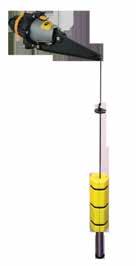


Detach to Clean • Stainless steel bracket and Shaft • Fits plastic and concrete tanks • Rugged and long lasting

ATED Farmers president Jason Herrick says farmers are prepared for winter grazing every year.
However, he says they don’t always have the benefit of hindsight and can’t predict what weather will show up when.
“It’s all about controlling the controllables and having plans B right through to Z to deal with what the weather gods throw at us,” Herrick told
stuck in mud to the extent that they were not able to display normal animal behaviour like walking and turning freely to access feed or rest in dry areas,” Burrell says.
He says the farm was running more than 2,000 head of stock on a relatively small area of land, something that contributed to the creation of mud and animal welfare issues.
Animal Welfare Inspectors had visited FFPM Grazing Limited’s leased property near Tuatapere following a complaint.
“It’s all about controlling the controllables and having plans B right through to Z to deal with what the weather gods throw at us.”
He says that the winter grazing regulations introduced by the previous government were “completely unnecessary” because most farmers were already following good practice.
“There were a lot of costly, unworkable rules put in there as well which, in turn, had farmers thinking of ways to get around them because of the cost and ultimately led to some worse situations,” he says.
Herrick’s comments follow the news that a Southland livestock grazing company was fined $48,750 for allowing hundreds of cattle to graze in mud.
FFPM Grazing Limited pleaded guilty to four charges under the Animal Welfare Act in October last year. Last month, the company was sentenced in the Invercargill District Court.
The company was also ordered to pay the Ministry for Primary Industries (MPI) $15,000 in costs.
MPI director of compliance and response Glen Burrell says the winter grazing practices at the property were appalling.
“Many of these animals, around 125, were
welfare. It ensures animals have sufficient and appropriate feed, access to plenty of clean water, and the ability to move freely to and from their feed and water,” Burrell concludes.
MPI strongly encourages any member of the public who is aware of animal ill-treatment or cruelty to report it to the MPI animal welfare complaints freephone 0800 00 83 33.
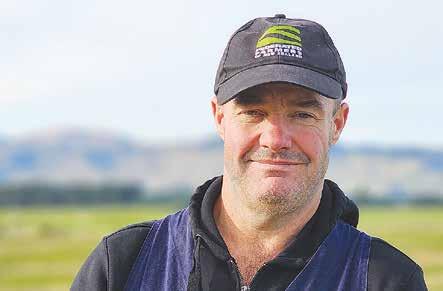
Burrell says their coats were caked in mud, didn’t have a dry lying area, and when they were lying down, they were lying in mud.
“MPI’s investigation found that former farm workers at the property had warned the company and directors who leased the property against using silage stacks. The property owner reiterated these concerns to one of the grazing company directors, but no action was taken,” he says.
“We continue to engage with farmers and industry about winter grazing and have seen some good progress. We proactively visited around 20 proactive properties throughout Southland during winter 2024 and found most farmers were on top of their winter grazing requirements with good plans in place,” Burrell says.
“Most farmers work hard to the right thing and have improved their winter grazing practices over recent years,” he says. “This case is an important reminder to plan ahead and get on top of problems before they develop.
“A well-planned winter grazing system supports good animal health and


NIGEL MALTHUS
REDUCING NITROGEN
inputs does not necessarily mean reducing profits, says DairyNZ principal scientist Ina Pinxterhuis.
Speaking at a recent North Canterbury dairy farm field day, Pinxterhuis reviewed the more than a decade of research which she had been involved with, seeking water quality improvements and contaminant mitigations.
She said the first focus of the research was reducing applied nitrogen inputs, which is now capped at 190kg/ ha/year – down from the 250-300kg/ha which was common at the time.
When she asked for a show of hands, none of the farmers attending the field day admitted
to noticing lost production after the cap was imposed.
“That’s a good sign because it does mean that with a lower amount, with that nitrogen cap of 190 we have been able to maintain production,” said Pinxterhuis.
She said it was all about the four Rs: Right place, Right time, Right rate, and Right product.
Urea should be applied so that there is time for the nitrogen to become available for the plant to take it up, and also time for that nitrogen in the plant to be converted to proteins.
It was important to graze or cut at two and a half to three and a half leaves, when there was optimal use of nitrogen, exponential growth rates, and good quality.
Summarising results of a Pastoral 21 study com-

paring Canterbury farms between 2011 and 2015, Pinxterhuis said restrict-



ing nitrogen application did have a check on production but not on profitability.
That study compared a high input farm applying 304 kgN/ha on a stocking rate of 5.0, with a low input farm applying 156 kgN/ha on a stocking rate of 3.5.
Average production of the high input farm was 2241 kg MS/ha and average operating profit $4,205/ha. The low input farm produced only 1,700 kg MS/ha but recorded a profit of $4,300/ha.
The average N leaching was 46kg/ha and 32kg/ ha respectively.
“So the lower input system was more profitable than the higher input system.
“But we managed to reduce nitrate leaching by 30 percent and that was what we set out to do. Our models were show-
ing that and the measurements showed it as well.”
Pinxterhuis said more recent research by Lincoln University’s Racheal Bryant looked at different ways of applying the 190kg, whether a few larger applications or many smaller applications, and compared those regimes with pasture receiving no fertiliser.
Pinxterhuis said there was significant response to all N treatments, but the “interesting” finding was that after January, there was no difference in yields in the pastures that continued to be fertilised compared to the pasture that wasn’t.
The message was that farmers should focus on spring fertilising and production and to utilise that production, perhaps as silage.
There would be
some benefit of nitrogen applied later in the season in a new paddock still building up after renewal, but in a well-established pasture with adequate clover, the clover provides the nitrogen.
“Later in the season, just the natural processes can take over.”
Asked how much clover should be in pasture, Pinxterhuis said it was “a bit circular” because clover doesn’t get the chance to grow if you keep applying nitrogen. However, in that trial and others, clover was only about 10% of dry matter on average. Clover might be barely visible in spring but make up to 20 to 30% in summer, when it is flowering and easily seen, she said.
Pinxterhuis also outlined the research around plantain as a nitrogen
reducer, citing a current study comparing nitrate leaching from a pasture of just perennial ryegrass and white clover, and another with 15-30% plantain.
She acknowledged that like many farmers they were struggling to maintain the plantain percentage but were still recording worthwhile N leaching reductions.
“In the graph you see what the plantain content was that we achieved –24% in the first year, 17 in the second 12 in the third.
“But you can see also that the total nitrogen leaching was actually a lot lower still on the plantain – on average, 23% in the first two years.
“In the third year, we don’t have all the data yet but the data up till August is in the graph and it’s still showing a significant reduction.”
JOHN DEERE has started the New Year with the release of JDLink Boost, using a satellite connectivity solution to ensure customers continue seamless work in fields with little to no cellular coverage.
The new JDLink Boost option supports the partnership, announced a year ago, between John Deere and Starlink by SpaceX network, providing farmers who face rural connectivity challenges with the opportunity to fully leverage precision agriculture technologies.
“With real-time access to data on machine usage and performance, John Deere can provide predictive maintenance recommendations.”
JD Link Boost will especially benefit farmers when they are operating in fields where cellular coverage is limited or unreliable. A secure and faster connection in the field provides farmers real-time access to their machine and agronomic data. Improved connectivity allows for timely decision-making regarding irrigation, fertilisation, pest control and harvesting.
Precision ag technologies that benefit from improved connectivity include:
■ In-Field Data Sharing in real time can lead to more efficient application processes and reduced waste.
AutoPath automates the creation of paths based on field boundaries to reduce setup time for more efficient field work, while remote monitoring &
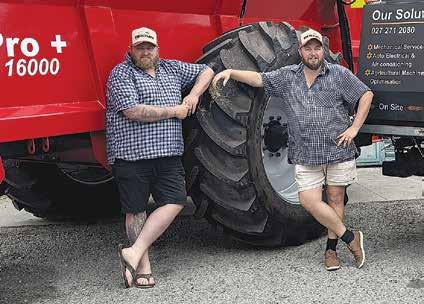
AUSTRALIAN AGRICULTURAL equipment distributor, Waringa Distribution, has increased its support to South Island farmers and contractors with the appointment of Brown Agri Solutions at Hororata, near Christchurch, as a sales agent.
Supplying brands such as AgriSpread, Gregoire Besson, Geringhoff and Highline, Waringa Distribution commenced distribution in New Zealand in mid-2024, appointing Chris Tricker to a sales and business development role, and to oversee its distribution centres in the South and North islands.
Brown Agri Solutions was established in 2020 by Conor Brown as CSB Mechanical at Hororata.
He was recently joined by his brother Fin, to operate under the new banner to support the Canter-
bury region. Originally from Devon in South-West England, both have also gained invaluable experience in Western Australia, where Fin worked with a major machinery dealer group in servicing and sales, including as a precision system specialist.
The brothers aim to provide a “one-stop solution”, including across mechanical servicing and repairs, machine and instrument optimisation, precision agriculture systems, autoelectronics, diagnostics and machinery sales.
Waringa Distribution was keen to add further new sales agents across its network in New Zealand and looked forward to flying the Brown Agri Solutions flag and meeting with growers and the industry at the South Island Agricultural Field Days at Kirwee in March. – Mark Daniel
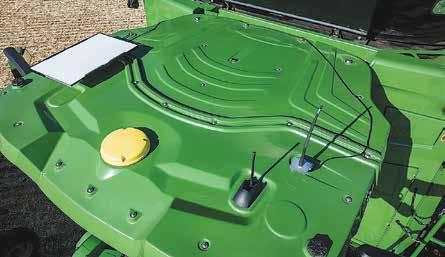
alerts help to identify inefficiencies as they occur to help ensure equipment is running at optimal levels.
■ Faster and more reliable connectivity helps farmers and dealers
more quickly diagnose machine issues, helping reduce downtime and ultimately boosting operational efficiency
“With real-time access to data on machine usage and performance, John Deere can provide predictive maintenance recommendations, which helps farmers schedule maintenance activities at convenient times, reducing unexpected breakdowns
and ensuring equipment is always operational,” said Stien, JD go-to manager for digital technologies.
“JDLink Boost enables secure transmission to Connected Support, allowing technicians to remotely diagnose issues with equipment, speeding up repairs and reducing the need for on-site visits, saving farmers time and money.”
JDLink Boost adds the next layer to John Deere’s precision technology strategy to enhance connectivity on the farm to increase productivity and efficiency for farmers.
Visit deere.com or your local John Deere dealer for information.
















IT HAS been a year of new products and innovation at Numedic, the Rotorua-based manufacturer and exporter of farm dairy effluent equipment.
Apart from bringing the K2 King Cobra under their umbrella, which has received support from customers and dealers nationwide, Numedic has also developed a new range of effluent stirrers for tanks, sumps and ponds.
Precisely engineered and made from high quality components and fully hot dip galvanised for longevity in the harsh effluent environment, regardless of your storing solution, Numedic has a suitable stirrer.
The range consists of the PondMix, suitable for various size ponds. With the boom length up to nine meters, and a high-

quality industrial mixer head, this stirrer provides maximum efficiency and stirring effectiveness with less energy required.
The boom can be rotated and adjusted, and incorporates the suction pipe and a flexible hose to the pump, eliminating the
need for a separate suction hose. The convenient sectional design also makes the boom easier and less costly to
freight. Numedic’s TankMix - for above the ground tanks. Designed to reach over the wall, this mixer
features the same high quality mixer head, a sturdy galvanised frame and smart design features, making it easy
to use. The mixer head can be directed up and down, and rotated, to direct the stirring effluent jet to break up the solids, or the crust. The special TankMix can also be made for tanks and sumps where both can be stirred at the same time by the same stirrer.
In addition, the SumpMix is ideal for stirring sumps, providing the optimum homogeneous effluent, ready to irrigate or transfer, and eliminating the crusting.
All the mixers are easy to install, operate and maintain.
A smart, easy to install effluent system consisting of the Numedic products will ensure compliance, maximise your return on investment and the best use of effluent on your farm.
Article supplied by Numedic www.numedic.co.nz

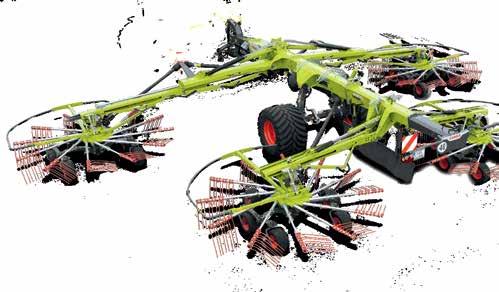
WITH EFFLUENT becom-
ing a more important part of farm management, particularly for its value as an alternative to “bagged” fertiliser, it is timely for the Power Farming Group to be introducing the Fliegl range of tankers.
Offering a range of sizes up to 27,500 litres, the German-built machines also offer tandem and triple-axle layouts in the Maxx Line Plus and Alpha Line models. Maxx Line Plus is equipped with tandem
The Skate trailing shoe configuration features spring loaded injection shoes with an 8kg blade pressure, mechanical or hydraulic section control and an outlet spacing of 250mm.
lower the centre of gravity by around 20cm, making them particularly suitable for hilly areas. As an option, customers can specify air or hydraulic suspension that allows lift axles and helps reduce ground compaction.
Standard tyre equipment on the Maxx Plus Range is 750-60R 30.5 profile, each rated to
into traps at the end of the distribution trough, with benefits said to be reduced wear compared to bladed macerators and a uniform flow of material to the outlets.
Final application is taken care of by dribble bar, trailing shoe or disc injection set ups. The former is available in operating widths from

axles and available in 12,000, 14,000, 16,000, 18,00 and 20,000 litre capacities, while the triple-axle Alpha Line is offered with 23,000, 25,000 and 27,500 litre sizes, meaning that the two ranges can be towed with tractors from 100 to 250hp.
As the tankers are expected to carry large weights, suspension systems are an important consideration, so 12,000 and 14,000 litre Maxx Line Plus units are fitted with Fliegl’s Giant assembly, utilising springs and HD bearings to offer individual wheel guidance.
The Giant Plus format, used on 16,000 to 20,00 litre machines, is maintenance-free, using rubber mounts, and designed specifically for high axle loadings, using trailing arms for high speed and cornering stability.
On larger tankers of 23,000 litres and above, the Jumbo Giant Plus assembly features parabolic springs that help
6740kg capacity at 40kph and are also recommended as an upgrade for the Alpha Line Series. Likewise, forced steering upgrades help manoeuvrability, particularly when reversing and help to reduce tyre wear. At the heart of the system K50ball joints are connected to link arms situated on each side of the drawbar and connected to the tractors hydraulic system. In operation, the pressurised system forces the oil displace to turn the steering axles in opposing directions, meaning the machine track closely follows that of the tractor.
At the rear of the machine there is a focus on moving away from traditional splash-plate designs to place effluent directly on or in the ground, helping to reduce nitrogen losses and odour. A ground distribution systems start with a unique screw type delivery manifold that serves to remove foreign objects


6 to 18m, with 24 to 72 outlets respectively. The units fold to a compact 2.6m for transport and offer slope compensation and over-pressure functions.
The Skate trailing shoe configuration features spring loaded injection shoes with an 8kg blade pressure, mechanical or hydraulic section control and an outlet spacing of 250mm. Offered in working widths of 9 to 21 metres, with 36 to 84 outlets, booms fold to less than 3 metres for transport.
The Vario Disc injection system is said to be capable of placing effluent between 5 and 10cms below ground level, using 530mm diameter angled discs spaced at 25mm across operating widths of 3 to 7.5 metres with 11 to 28 discs respectively.
A range of options includes foam separators, suction nozzles with docking stations, turbo fillers and discharge accelerators
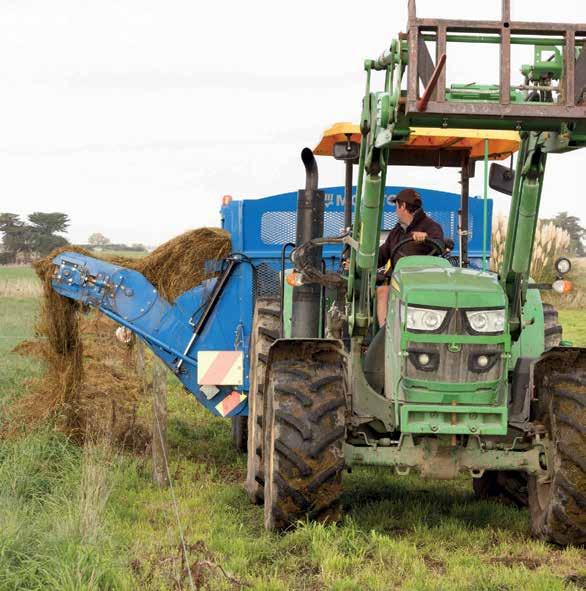

Successful forage brassica and pasture production is highly dependent on the first six weeks of a plant’s life. Ultrastrike® and Superstrike® seed treatments include insecticides, fungicides and nutrients to maximise seedling establishment, helping to deliver higher yields and improved animal production. For more information, talk to your local seed retailer or visit seedtreatment.co.nz PROTECT YOUR SEED, PROTECT YOUR FUTURE.